Delve into the past with 45 remarkable ancient Egyptian mummies, showcased through captivating photos. Unearth history's enigmatic faces.
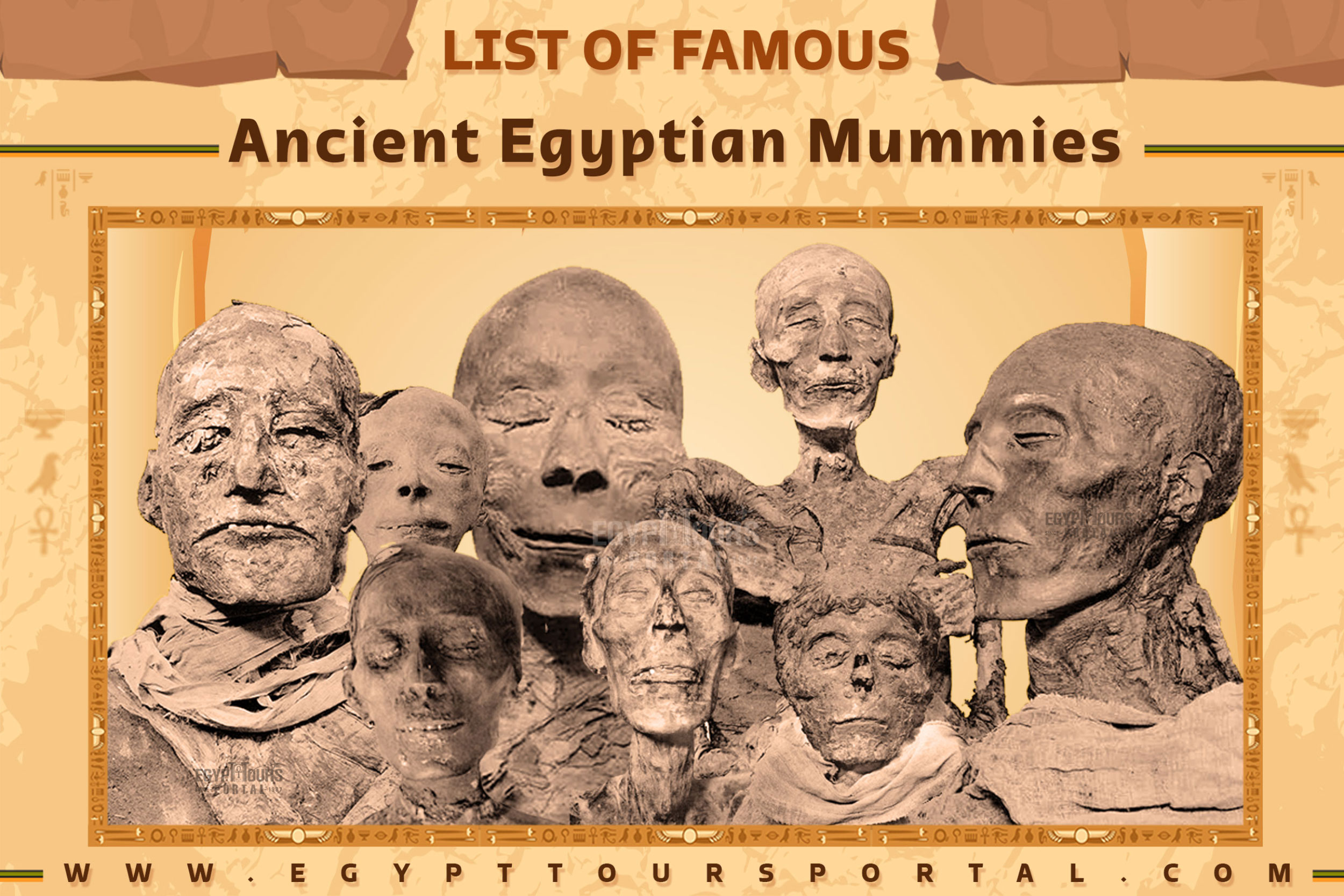
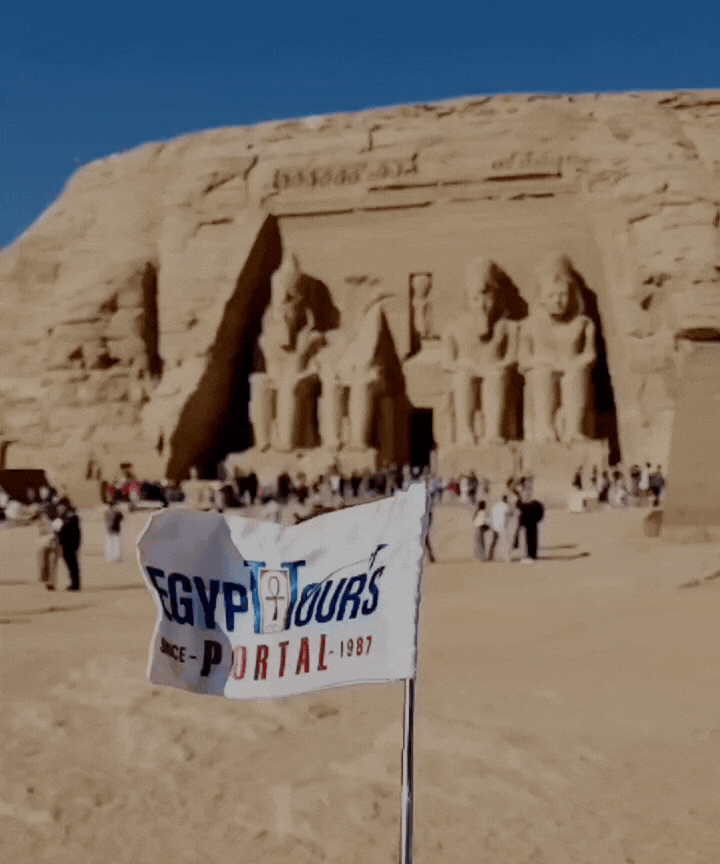
The Ancient Egyptian Mummies can be seen as the ultimate example of medical advances, mythological religious beliefs, and dedication to harnessing the power of the beyond. Over thousands of years, the ancient Egyptians founded, mastered, and developed the process of mummification to preserve the body of the deceased until their time comes and they are called to stand in front of the deities of Egypt and earn their way to the field of Reeds. The ancient Egyptians practiced mummification as the ultimate means to preserve dead bodies, to ensure the deceased's body remained lifelike and decay-resistant which involved removing moisture to leave a desiccated form that will enable the ka or soul to find the body once again in the afterlife after awakening. The ancient Egyptian mummies are able to radiate all the funerary rituals and tell the magnificent stories of great men and women.
In this article, we embark on an illuminating journey through the annals of ancient Egyptian history, guided by the presence of 45 ancient Egyptian mummies. These captivating relics, carefully selected from diverse epochs, unveil the fascinating tapestry of Egypt's past.
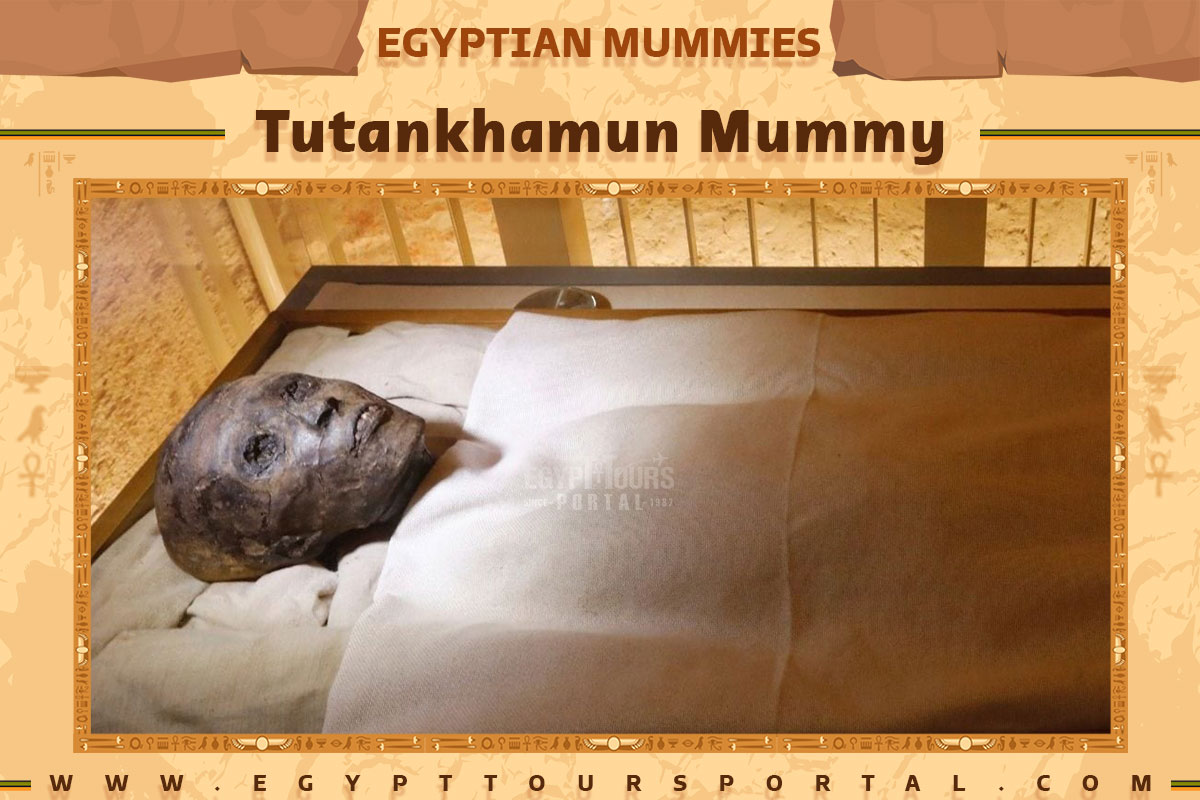
The tomb of Tutankhamun was discovered in 1922 by Howard Carter in the Valley of the Kings which remains the last preserved tomb in all of Egypt. This discovery is by far the most recognizable which started a new wave of interest in Egyptology. His mummies are found at the Grand Egyptian Museum with his treasures. Tutankhamun's mummy was discovered in poor condition in 1925, with carbonization of wrappings and tissues likely caused by unguent and fungi in the tomb. This contrasted with better-preserved mummies of other rulers. The mummy was cut into sections for examination, revealing Tutankhamun's age and royal lineage.
In 1968, an X-ray examination discovered dismemberment not mentioned before. The mummy had deteriorated further since 1926, showing missing skin, open eyes, a missing collar, and limb disarticulation. X-rays indicated different mummification positions and small bone fragments, fueling murder theories. In 2005, a CT scan ruled out murder, revealing a cleft palate, an elongated skull, and a leg fracture. Tutankhamun's health and cause of death remain contentious. Genetic tests in 2007-2010 aimed to determine his identity by comparing his DNA to other mummies in tombs KV55 and KV35.
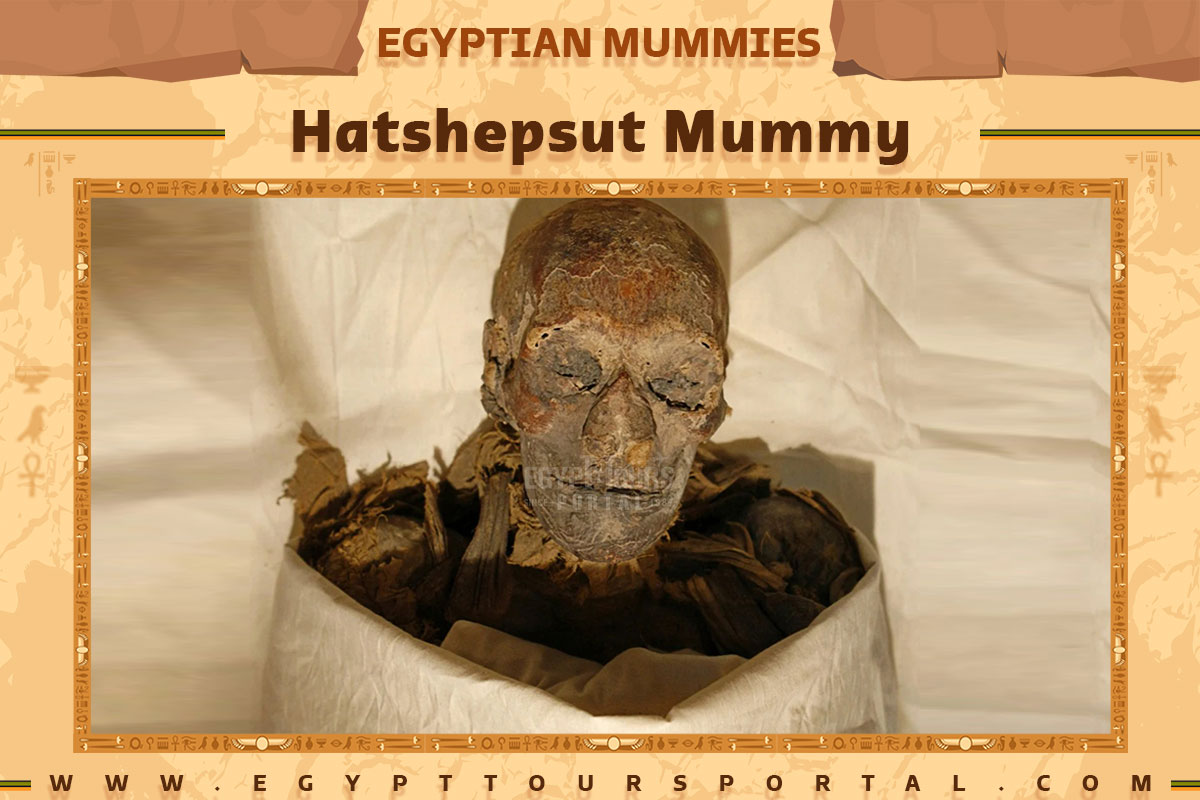
Queen Hatshepsut was buried in the Valley of the Kings which was discovered by Howard Carter in 1902 and was confirmed in 2006 by the Egyptian Ministry of Antiquities and Tourism. She was located in a separate tomb containing two ancient Egyptian coffins. She was most of the most powerful rulers in the history of the New Kingdom who ruled with an iron fist as a pharaoh. Her mummies are found at the National Museum of Egyptian Civilization. Her tomb held two female mummies one was identified as Hatshepsut's wet nurse, while the other remained unknown. In 2007, researchers removed the unidentified mummy, known as KV60A, from the tomb, and believed it might be Hatshepsut based on a missing tooth that seemed to match a molar found in a canopic box associated with her.
DNA testing was not pursued to confirm this, as it would damage the tooth. A theory emerged that Hatshepsut might have accidentally poisoned herself with a carcinogenic skin lotion, possibly contributing to her death, along with other health issues like arthritis and dental problems. However, doubts arose in 2011 when it was revealed that the tooth in the canopic box was from the lower jaw, while the mummy from KV60 was missing an upper jaw molar, raising questions about the connection between the mummy and Hatshepsut's identity.
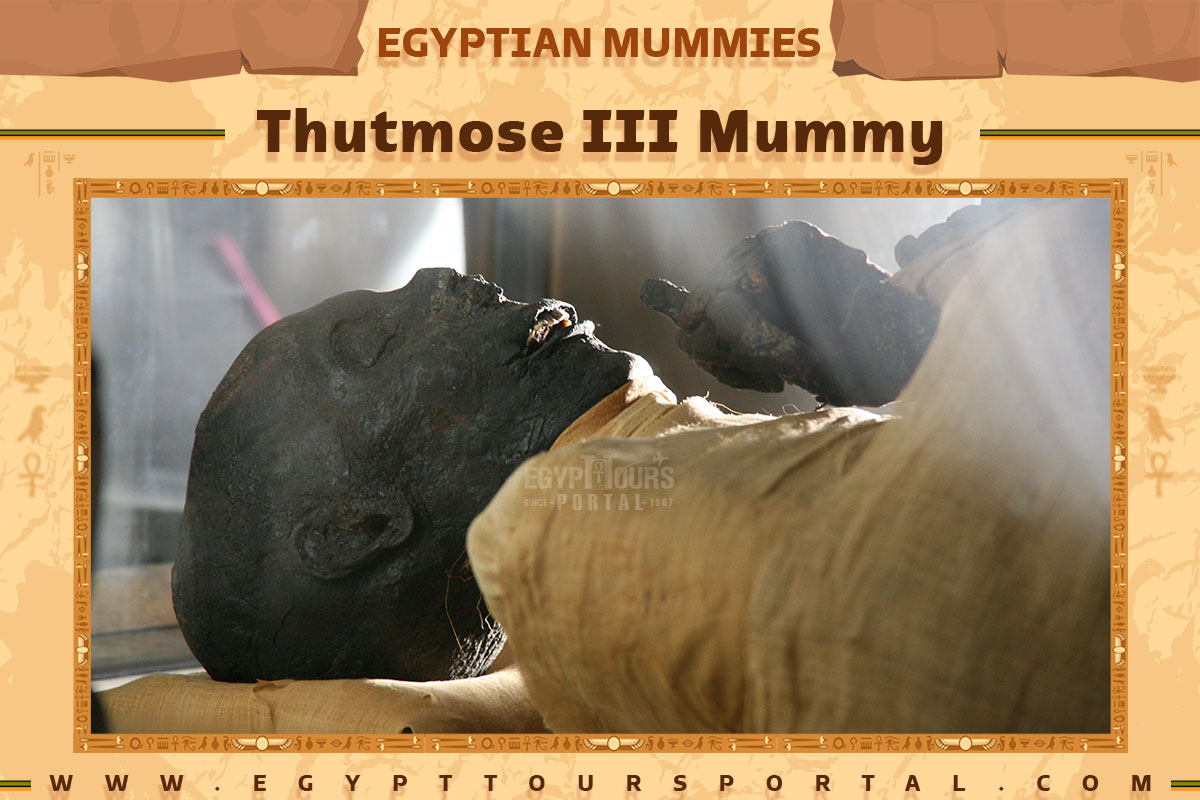
Thutmose III was known as the Napoleon of Egypt who conquered many lands won many battles, and expanded the lands of Egypt. He came to the throne of Egypt after Queen Hatshpeut and was buried in the Valley of the Kings which is now located at the National Museum of Egyptian Civilization. Thutmose III's mummy was found in the Deir el-Bahri Cache in 1881, alongside mummies of other ancient Egyptian leaders from the 18th and 19th Dynasties. In 1881, this initial unwrapping revealed that the mummy was in poor condition, likely due to damage by tomb robbers. The mummy had suffered extensive damage over time, with its wrappings torn and its body needing restoration before reburial.
Unlike some mummies from the cache, Thutmose III's wooden mummiform coffin was original, though its gilding and decoration had been removed later on. In 1980, X-ray examinations revealed that the 18th Dynasty royal mummies, including Thutmose III, had similarities to contemporary Nubians with slight differences. Thutmose III's height is 1.615 meters (5 feet 3.58 inches), though the mummy was missing its feet. Until 2021, Thutmose III's mummy was housed in the Royal Mummies Hall of the Museum of Egyptian Antiquities. It was then relocated to the National Museum of Egyptian Civilization as part of the Pharaohs' Golden Parade, along with mummies of other kings and queens.
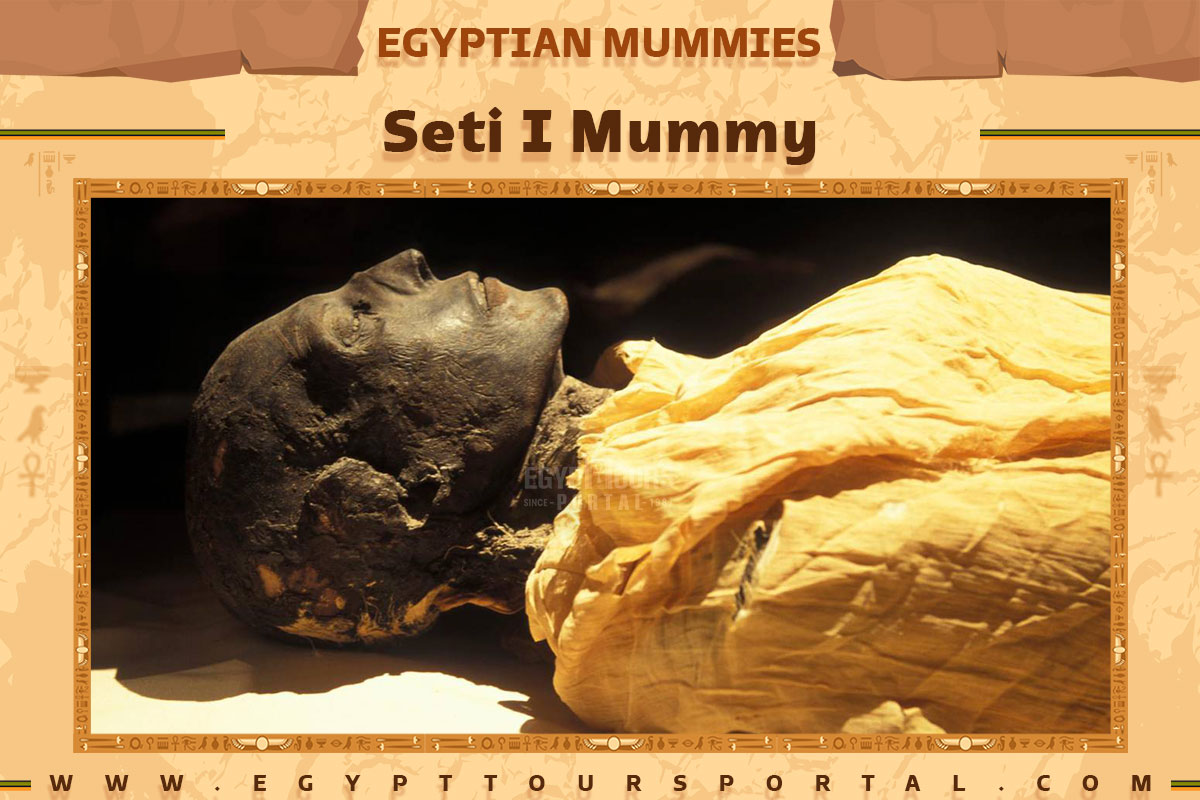
The great protector Seti I is a legendary ruler who expanded his empire fortified the entire country and made many great construction projects. His tomb is by far the finest which was found in the Valley of the Kings and his mummy was moved to the National Museum of Egyptian Civilization. Seti I's well-preserved mummy indicates he died unexpectedly at less than forty years old, contrasting with the long lifespans of other pharaohs like Horemheb, Ramesses I, and Ramesses II. The exact cause of his early death remains uncertain, with no evidence of violence on his mummy. Seti I's mummy measured about 1.7 meters (5 feet 7 inches) tall.
His decapitation likely occurred post-mortem due to tomb robbers, and his head was carefully reattached using linen cloths. Some speculate he may have suffered from a long-term disease, possibly heart-related, as his heart was found on the right side, contrary to the typical left placement during mummification. In 1980, a number of researchers conducted X-ray examinations on Seti I's mummified remains, revealing strong similarities between the New Kingdom rulers of the 19th and 20th Dynasties and Mesolithic Nubian samples, as well as affinities with modern Mediterranean populations of Levantine origin. In 2021, Seti I's mummy was moved from the Museum of Egyptian Antiquities to the National Museum of Egyptian Civilization during the Pharaohs' Golden Parade event.
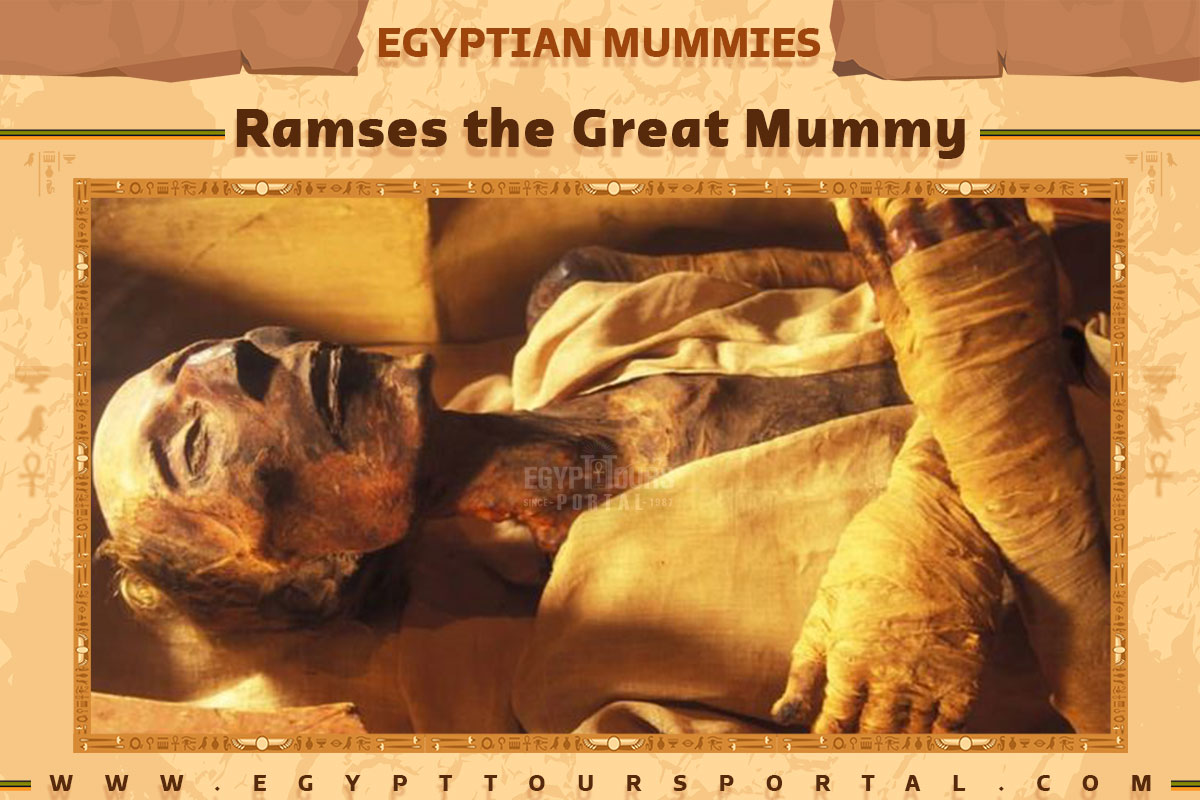
Ozymandias or Ramses II is one of the most renowned Pharaohs in the History of Egypt who won many battles like the battle of Kadesh in 1472 BC and constructed the Abu Simbel temple. He died at the age of 90 after her ruling for 60 years. His mummy and tomb were discovered in 1881 in the Valley of the Kings and it is now located at the National Museum of Egyptian Civilization. His body due to looting was moved to different locations, ultimately ending up in the tomb of the high priest Pinedjem II. This journey is documented in hieroglyphics covering his coffin's linen. Ramesses II's mummy reveals physical characteristics like an aquiline nose and a strong jaw, standing at approximately 1.7 meters in height.
Explore 50 famous Ancient Egyptian coffins with informative facts!
Read MoreHis hair was originally white but turned light red due to embalming spices. In 1976, the mummy was sent to France for treatment, and forensic analysis suggested that he had red hair, indicating he may have been from a family of redheads. However, this conclusion faced some dispute regarding determining ethnicity solely from hair morphology. After undergoing treatment in France, the mummy was returned to Egypt in 1977. Further studies in 1980 on Ramesses II's remains revealed battle injuries, fractures, arthritis, and poor circulation, with speculation that his arthritis may have caused him to walk with a hunched back. A hole in his mandible raised questions about potential infection as a cause of death. his mummy was moved to the National Museum of Egyptian Civilization in April 2021 in an event known as the Pharaohs' Golden Parade.
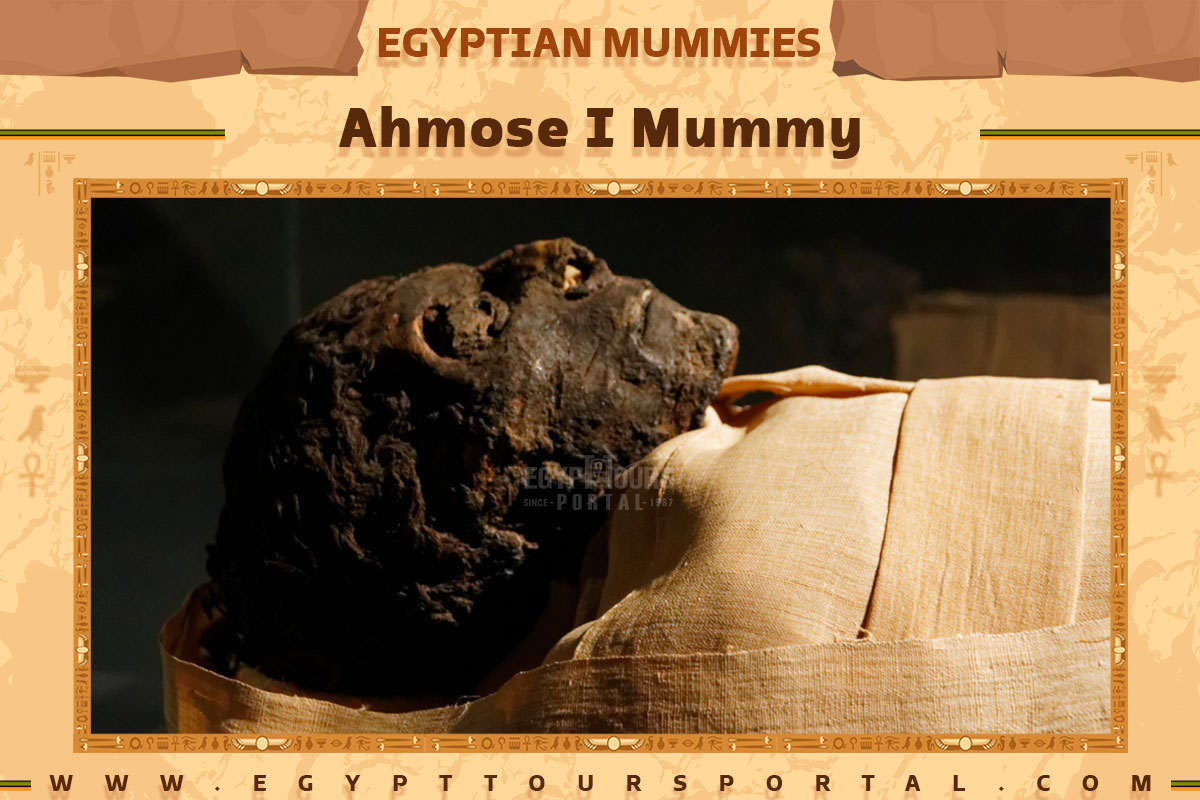
Ahmose I's mummy was discovered in 1881 within the Deir el-Bahri Cache, alongside other leaders of the 18th and 19th dynasties. Unwrapped by the prestigious Gaston Maspero in 1886, it was located within a cedarwood coffin with hieroglyphic inscriptions. The mummy had been moved and rewrapped during the 21st dynasty, with signs of robbery. The body was about 1.63 meters (5 feet 6 inches) tall, showing a small face with no distinct features. Notably, he had slightly prominent front teeth, possibly an inherited trait within the royal family.
Maspero's description highlighted the mummy's resemblance to his relative, Seqenenre Tao, indicating their familial connection. Initially believed to be in his 50s, later investigations suggested Ahmose I was likely in his mid-30s at the time of death. In 1980, doubts about the mummy's identity emerged due to craniofacial differences from both Seqenenre Tao and the female mummy Ahmes-Nefertari, traditionally considered Ahmose I's sister. This led experts to question if the mummy was truly that of Ahmose I, leaving his true identity uncertain.
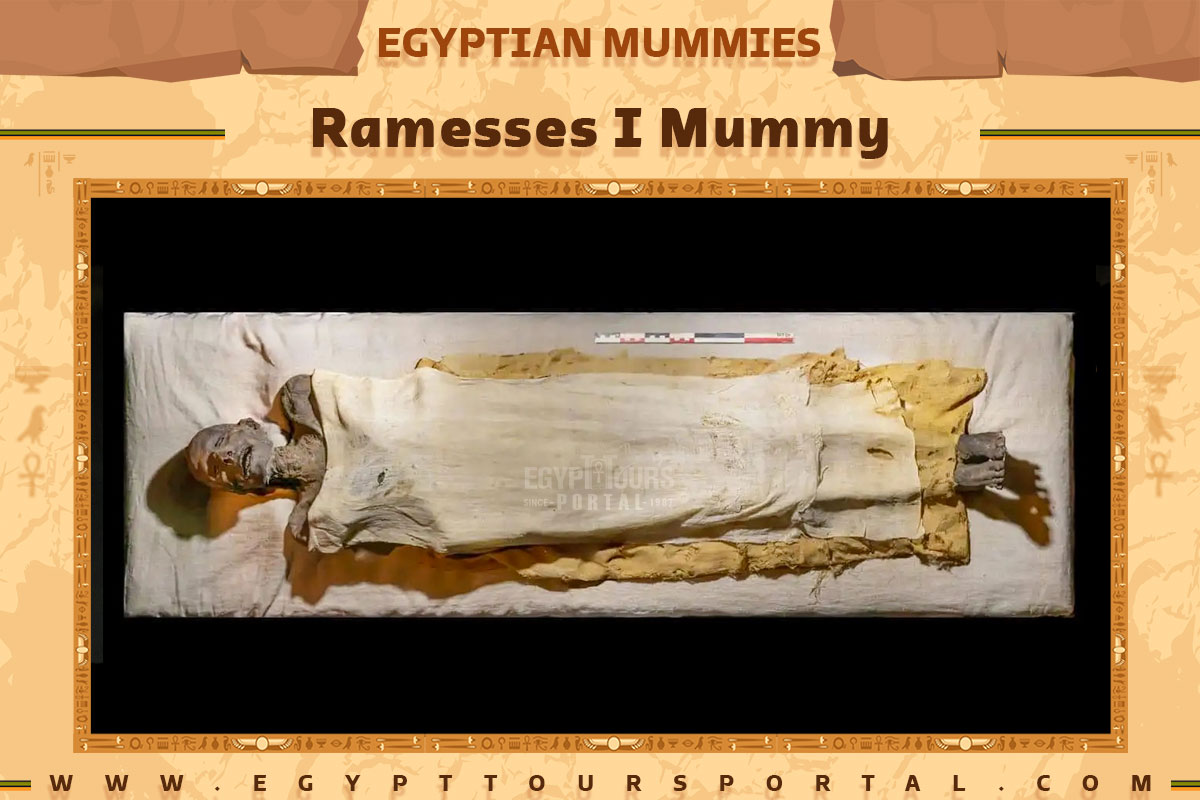
A mummy believed to be that of Ramesses I was stolen from Egypt and displayed in a private Canadian museum for years before being repatriated. Although its identity cannot be definitively confirmed, research involving CT scans, X-rays, skull measurements, and radio-carbon dating tests conducted by Emory University suggests it is likely Ramesses I.
The mummy's crossed arms positioned high across the chest, a royal gesture reserved for Egyptian royalty until 600 BC, also supports this belief. The mummy was stolen from the Royal Cache in Deir el-Bahari by grave robbers and sold to traders from North America in the 1860s. It ended up in a Canadian museum for over a century, among other curiosities.
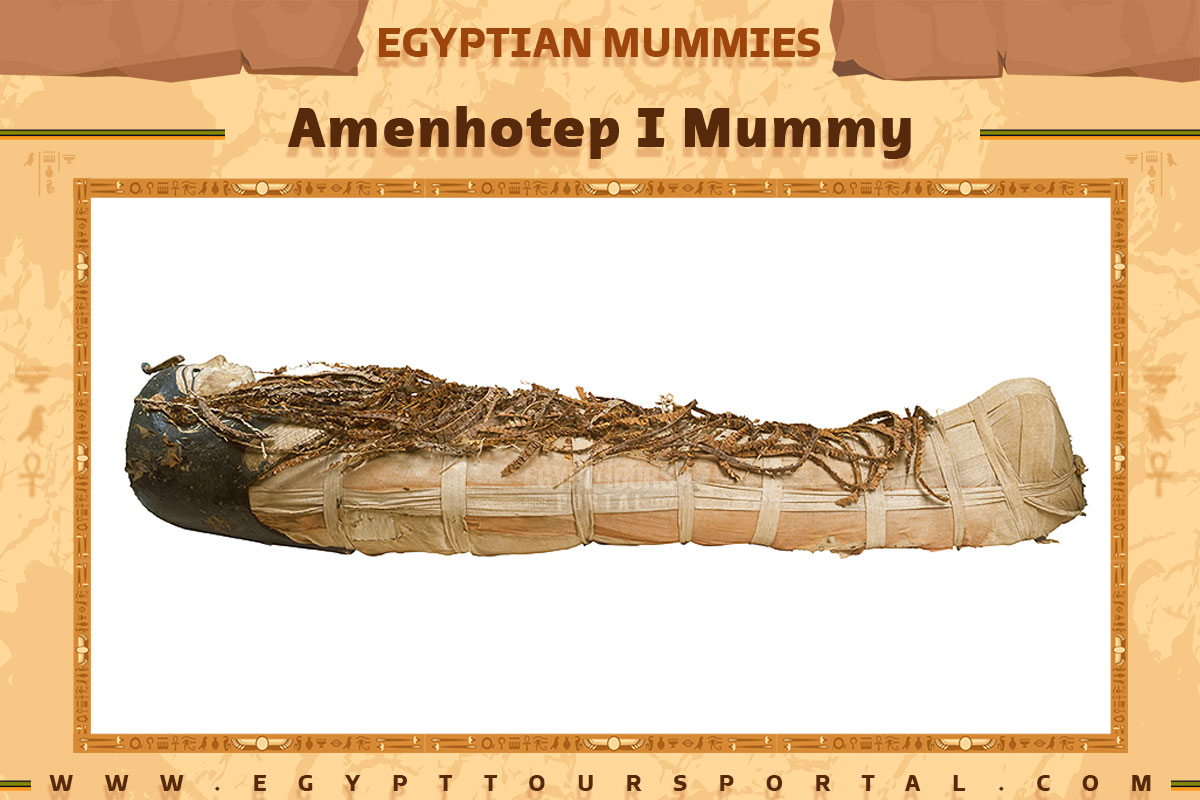
Amenhotep I's original tomb was likely robbed or deemed insecure during the 20th or 21st Dynasty. His body was subsequently moved for safety, potentially multiple times. It was discovered in the Deir el-Bahri Cache, alongside other New Kingdom kings and nobles, during or after the late 22nd Dynasty. The cache was located above the Mortuary Temple of Hatshepsut. The mummy remained well-preserved, and its cartonnage face mask was carefully preserved by the priests who relocated it.
Unlike other royal mummies that have been unwrapped and examined, Amenhotep I's mummy remains unexamined by modern Egyptologists. X-rays conducted in 1932 estimated his age at death to be between 40 and 50 years. Subsequent X-rays in 1967 suggested a much younger age of around 25 years, based on his well-preserved teeth.
In 1980, X-ray examinations of other New Kingdom Pharaohs' remains, including Amenhotep I, highlighted similarities to contemporary Nubians. In April 2021, his mummy was part of the Pharaohs' Golden Parade, where it was moved to the National Museum of Egyptian Civilization along with other royal remains.
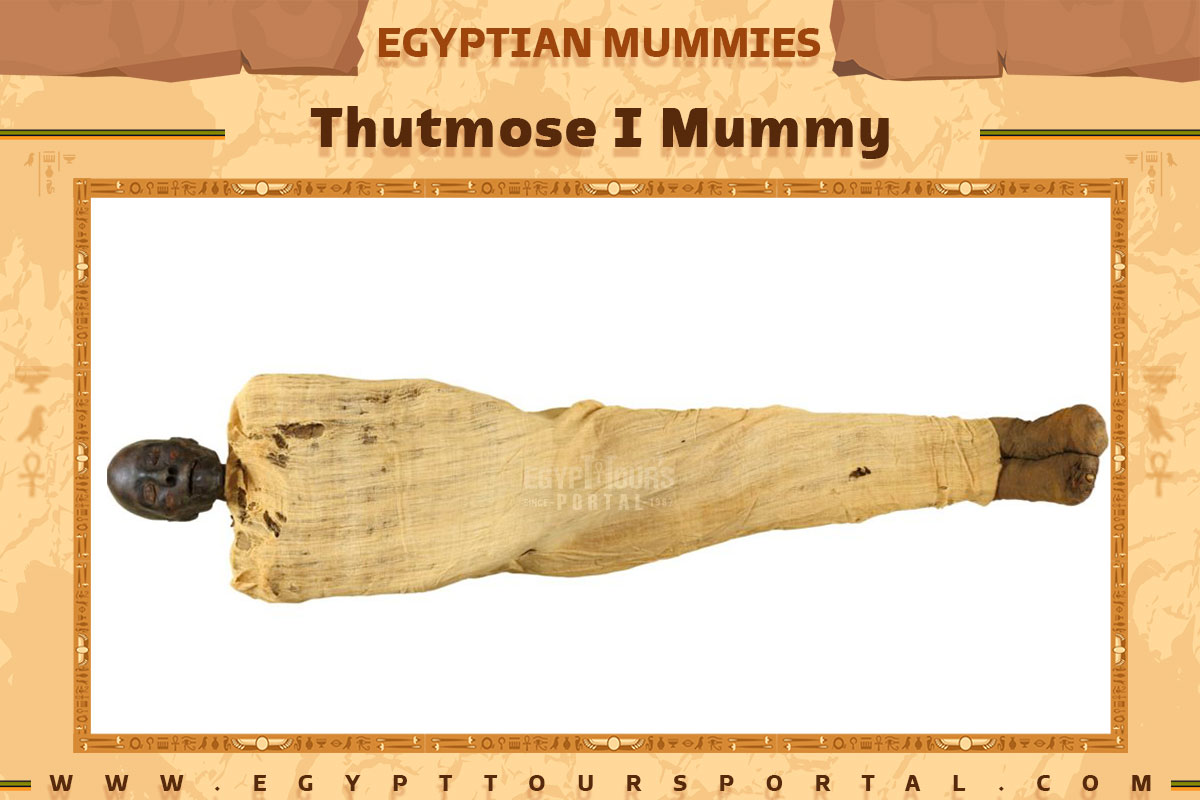
Thutmose I's mummy was discovered in the Deir el-Bahri Cache above the Mortuary Temple of Hatshepsut in 1881. He was buried with other leaders from the 18th and 19th dynasties, including Ahmose I, Amenhotep I, Thutmose II, Thutmose III, Ramesses I, Seti I, Ramesses II, and Ramesses IX, as well as pharaohs from the 21st dynasty.
Although the original coffin of Thutmose I was repurposed by a later pharaoh. Subsequent examinations supported this identification due to embalming techniques consistent with the Eighteenth dynasty period. Maspero described the mummy as small and emaciated, showing signs of muscular strength despite age. in 2007, It was announced that the mummy thought to be Thutmose I was actually a 30-year-old man who died from an arrow wound to the chest, indicating it likely wasn't the pharaoh himself. This mummy was moved in April 2021 to the National Museum of Egyptian Civilization as part of the Pharaohs' Golden Parade.
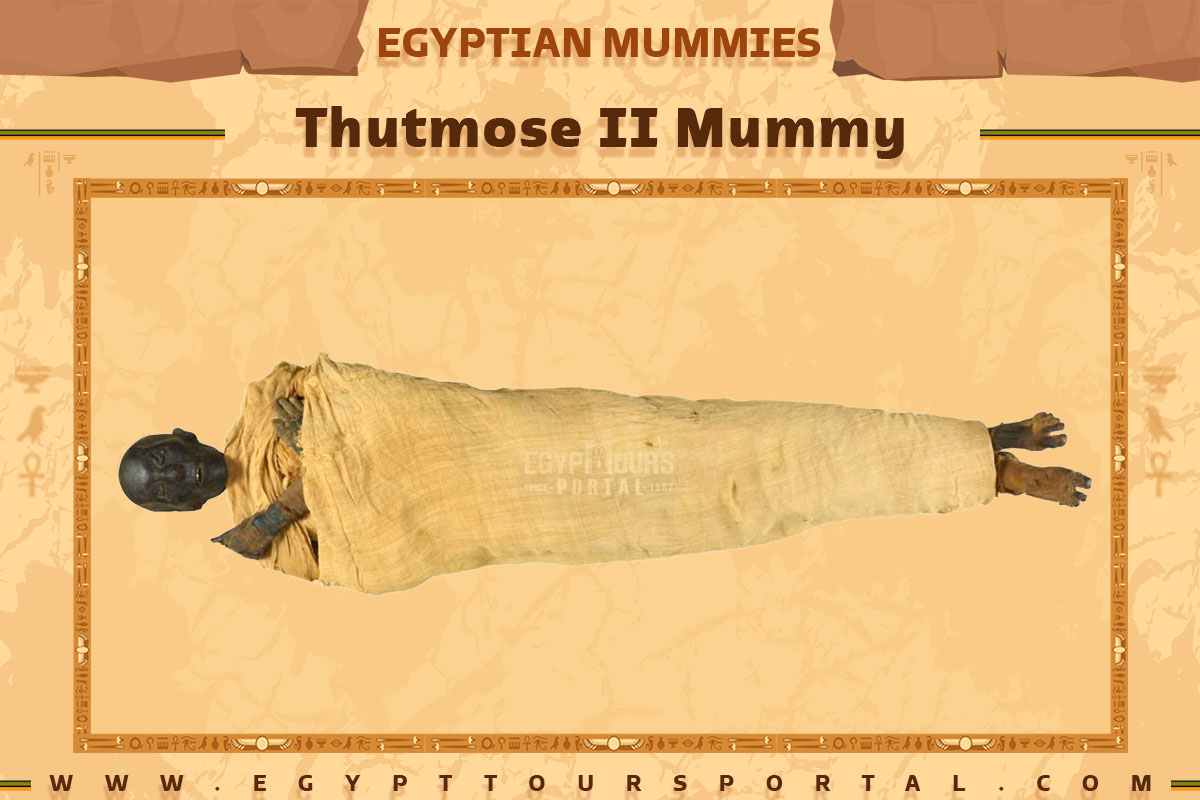
Thutmose II's mummy was found in the Deir el-Bahri cache in 1881, among other 18th and 19th dynasty leaders. The mummy displayed signs of post-mortem damage, with severed limbs and hacked wounds, likely due to tomb robbers. Unwrapped by Gaston Maspero in 1886, the mummy strongly resembled Thutmose I, possibly his father. The body bore signs of a challenging life and a disease that embalming couldn't hide, including scabrous patches, scars, a balding upper skull, thinness, and lack of muscular power.
X-ray studies indicated craniofacial traits common among Nubian populations. The mummy's re-wrapping label suggested Thutmose II's identity, but doubts emerged. The mummy was transferred to the National Museum of Egyptian Civilization in 2021 as part of the Pharaohs' Golden Parade. However, its identification remains questioned, as the re-wrapping label might have been modified from Thutmose I.
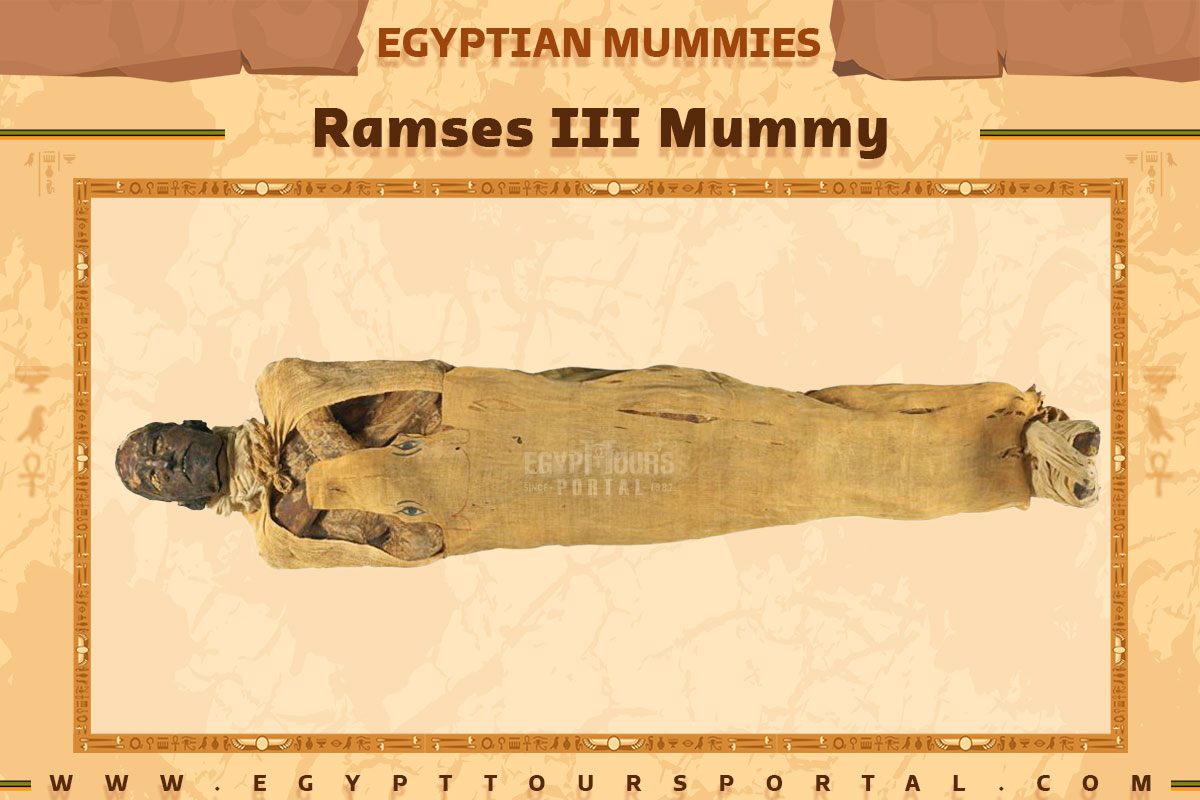
Antiquarians unearthed the mummy of Ramesses III in 1886, a find that has since become the quintessential representation of an Egyptian mummy depicted in numerous Hollywood movies. His final resting place, tomb KV11, ranks among the most expansive designs within the Valley of the Kings.
In 1980, a team led by James Harris and Edward F. Wente undertook a series of X-ray investigations on the crania and skeletal remains of New Kingdom Pharaohs, including the preserved body of Ramesses III. Their analysis unveiled significant parallels between the rulers of the 19th and 20th Dynasties of the New Kingdom and Mesolithic Nubian samples. Additionally, the researchers identified connections with modern Mediterranean populations of Levantine heritage. It was proposed that these findings indicated a mixture, as the Rammessides hailed from northern origins. A CT scan study of Ramesses III's mummy, revealed a significant finding: his left big toe had been severed, most likely by a heavy sharp object resembling an axe.
Explore the mystique of Ancient Egyptian mummification and its afterlife beliefs.
Read MoreThis injury showed no signs of healing, indicating it occurred shortly before his death. To address the loss, embalmers affixed a linen-made prosthesis-like object to replace the amputated toe. Intriguingly, six amulets were positioned around his feet and ankles, possibly for magical healing in the afterlife. This newly discovered foot injury supports the theory of the Pharaoh's assassination, suggesting multiple attackers employing different weapons.
In April 2021, his mummy, along with those of 17 other kings and 4 queens, was relocated from the Museum of Egyptian Antiquities to the National Museum of Egyptian Civilization. This event, known as the Pharaohs' Golden Parade, marked a momentous occasion.
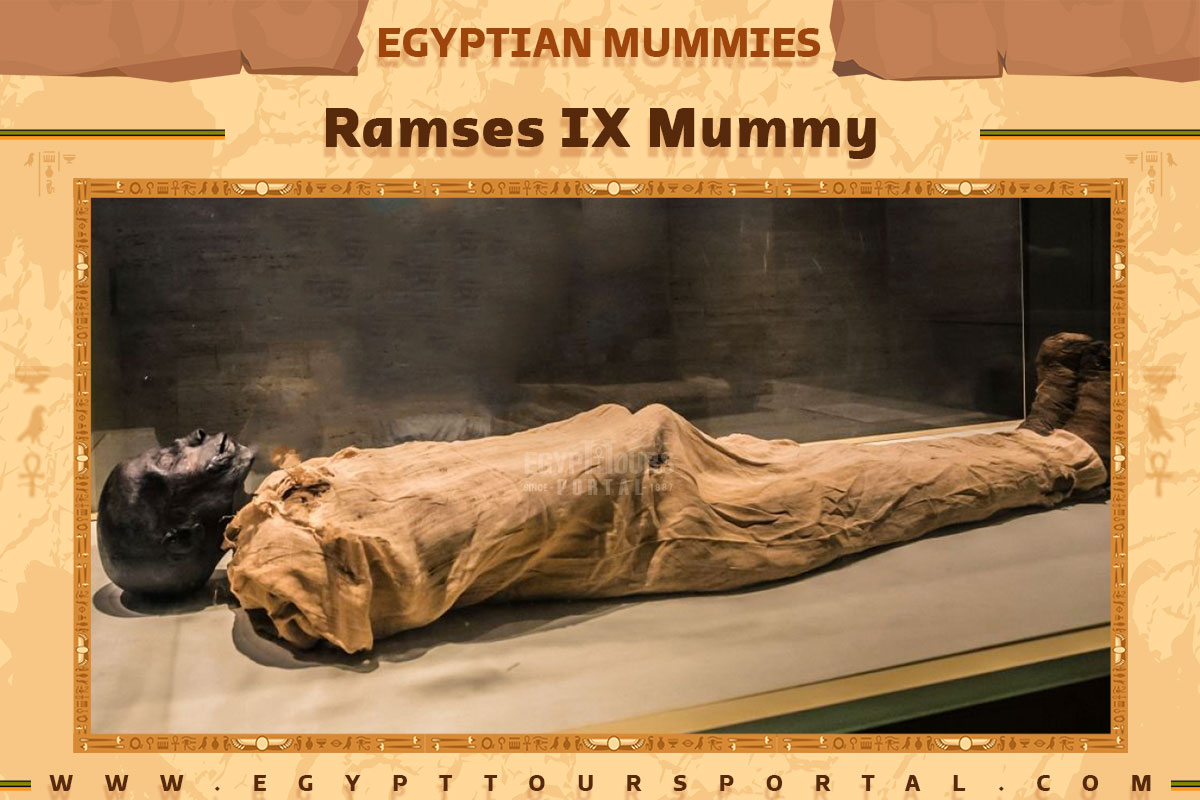
In 1881, the mummy of Pharaoh Ramesses IX was discovered within the Deir el-Bahri cache, located in the coffin of Neskhons, wife of Theban High Priest Pinedjem II. During its unwrapping by Maspero in 1912, a bandage with a reference to Neskhons from year 5 and another linen strip mentioning "Ra Khaemwaset" from year 7 were found, potentially linking the mummy to Ramesses Khaemwaset Meryamun (IX) or Ramesses Khaemwaset Meryamun Neterheqainu (XI).
However, due to the discovery of an ivory box of Neferkare Ramesses IX in the same cache and historical burial patterns, it's likely that the mummy is indeed that of Ramesses IX. The estimated age of death was around 50, though determining mummy ages is challenging. The mummy exhibited injuries like broken limbs, a neck, and a missing nose. In April 2021, Ramesses IX's mummy was transferred from the Egyptian Museum to the National Museum of Egyptian Civilization during the Pharaohs' Golden Parade, which included 17 kings and 4 queens.
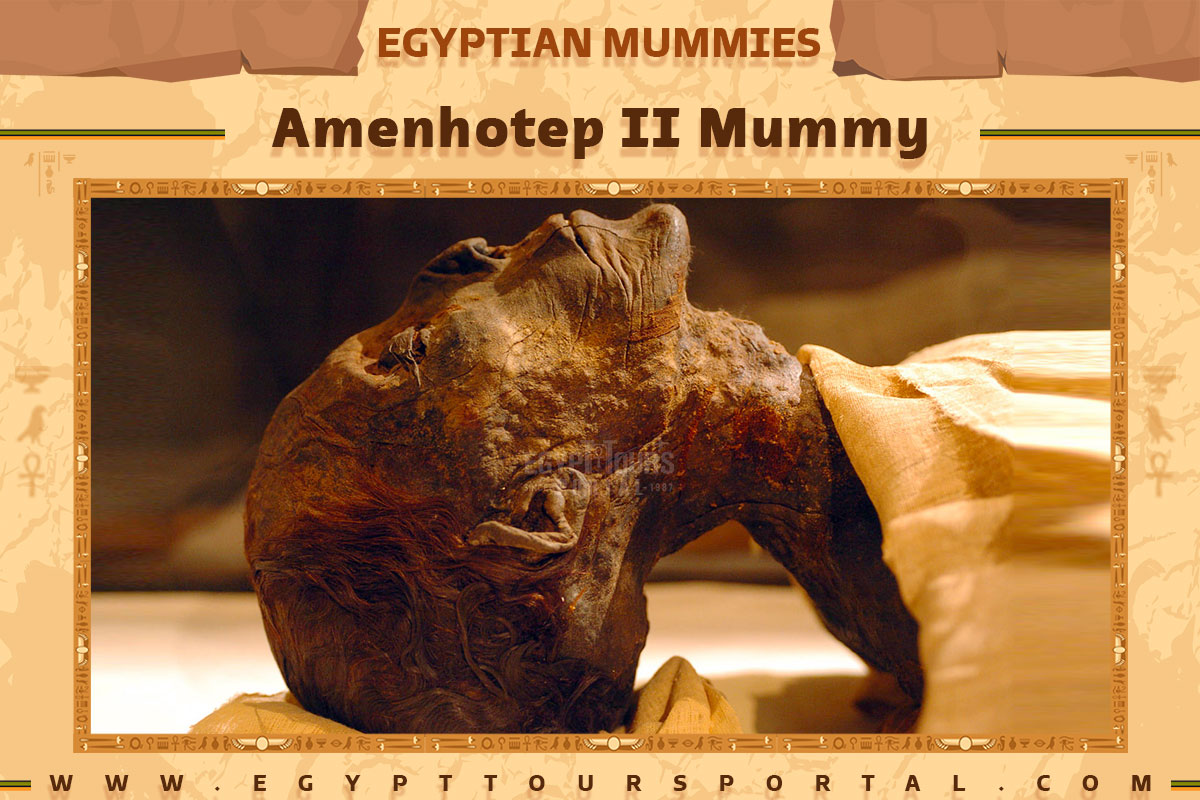
The mummy of King Amenhotep II underwent examination and documentation in January 1902 by Gaston Maspero, Howard Carter, and others. In 1907, anatomist Grafton Elliot Smith further examined the mummy, removing linen from the face to reveal a body 1.67 meters tall with white-infused brown hair and a resemblance to his son Thutmose IV. The body exhibited small tubercles, potentially from embalming or disease, and resin-preserved jewelry impressions, like a beaded collar and geometric pattern on the back. Smith estimated his age at death to be 40 to 50, based on dental wear and greying hair, but the cause of death remained unknown. The mummy is cataloged as CG 61069.
In 1980 X-ray examinations on Amenhotep II's mummy and others from the 18th Dynasty, found resemblances to Nubians with slight variations. In April 2021, Amenhotep II's mummy was relocated from the Museum of Egyptian Antiquities to the National Museum of Egyptian Civilization during the Pharaohs' Golden Parade.
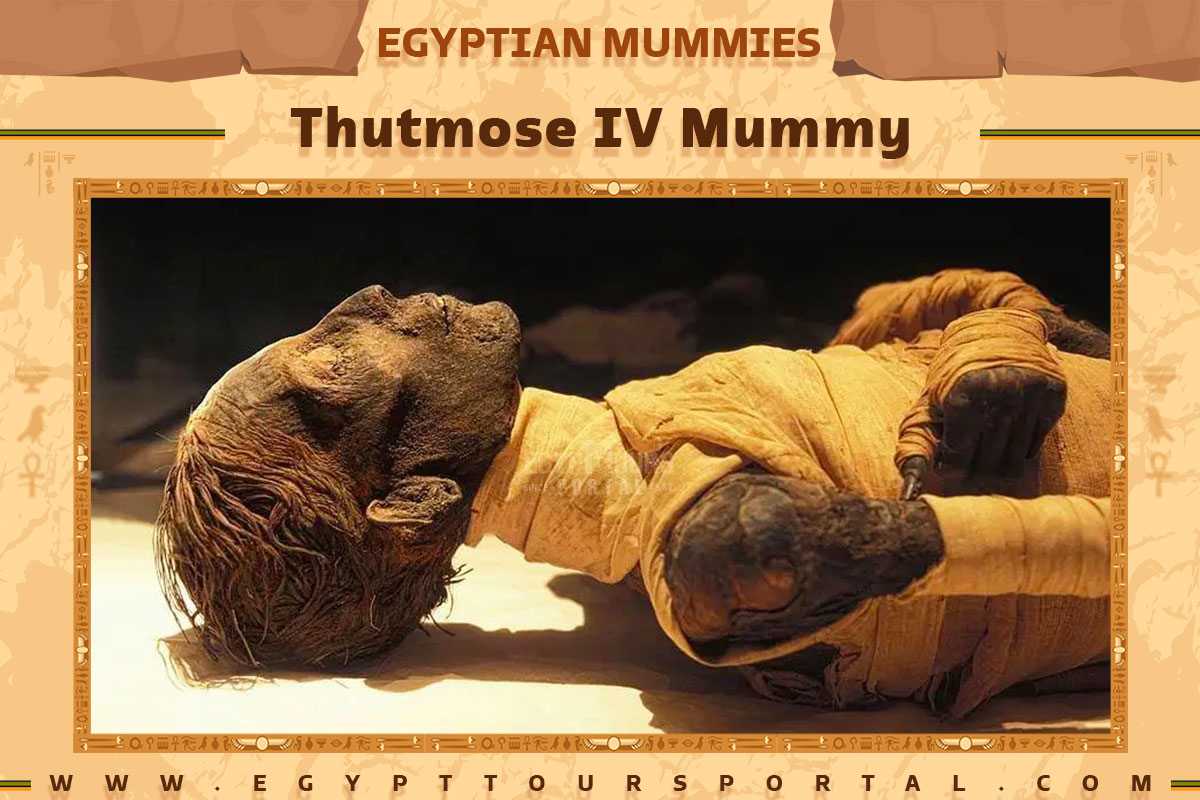
Pharaoh Thutmose IV was originally laid to rest in tomb KV43 in the Valley of the Kings, but later his body was relocated to the mummy cache in KV35, where it was discovered. Though his mummy lacked feet, his height was estimated at 1.646 meters (about 5 feet 4.8 inches), and his hair, dark reddish-brown and about 16 cm long, was parted in the middle. His crossed forearms and pierced ears were noted. his age was believed to be 25–28 years or potentially older.
In 1980, X-ray analyses on New Kingdom Pharaoh mummies, including Thutmose IV's, found resemblances to contemporary Nubians with minor distinctions. In 2012, many studied Thutmose IV's early demise and that of other 18th Dynasty pharaohs, attributing their premature deaths to familial temporal epilepsy. This condition could explain Thutmose IV's religious vision mentioned on the Dream Stele, linked to epilepsy linked with intense spiritual experiences. In April 2021, his mummy was transferred from the Museum of Egyptian Antiquities to the National Museum of Egyptian Civilization during the Pharaohs' Golden Parade.
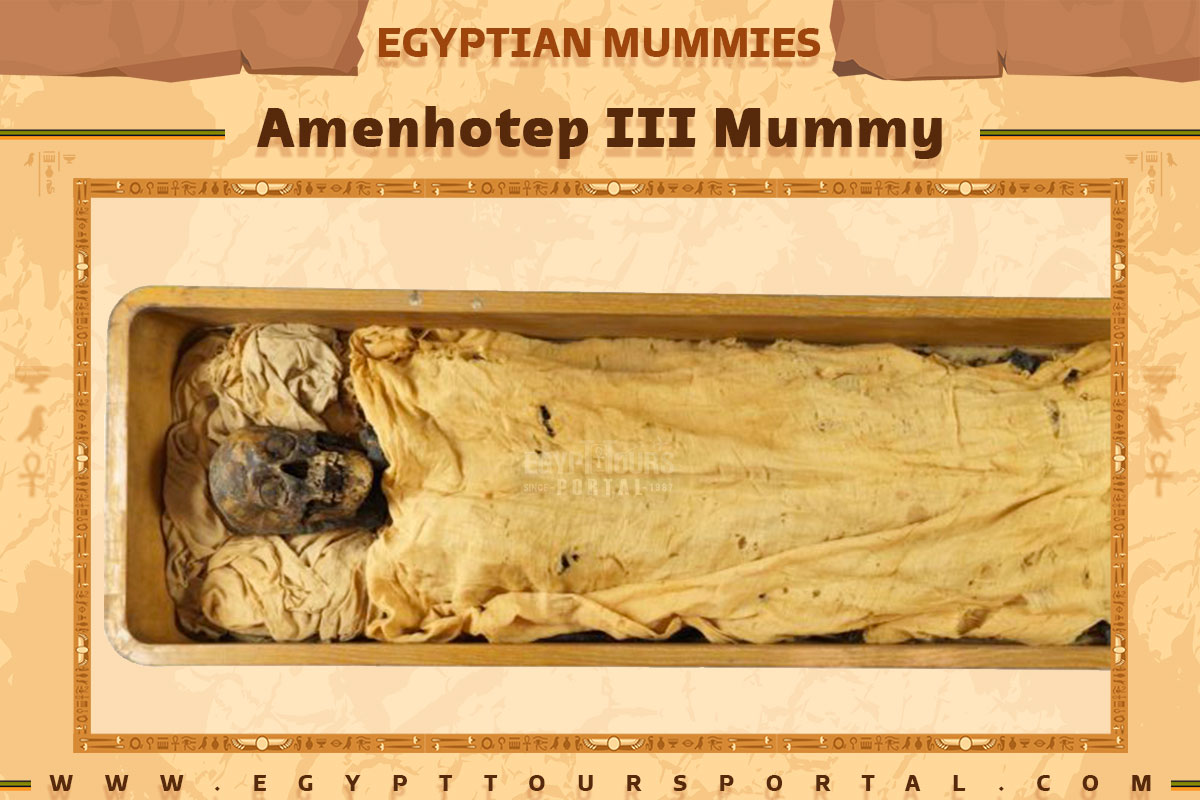
Pharaoh Amenhotep III was originally interred in Tomb WV22 found in the Western Valley of the Valley of the Kings. His mummy was later transferred, during the Third Intermediate Period, to a side chamber of tomb KV35 along with other pharaohs from the 18th and 19th Dynasties.
Notably, his mummy from the 18th dynasty exhibited an uncommon usage of subcutaneous stuffing to enhance its lifelike appearance. Initially buried in the Valley of the Kings outside Thebes, Tomb WV22 was significant in size and contained chambers intended for his Great Royal Wives; Sitamun and Tiye, although it seems they were not interred there. Subsequently, Amenhotep III's mummy was transferred to the mummy cache in KV35 during Smendes' reign.
In 1980, X-ray analyses on mummified remains of New Kingdom Pharaohs, including Amenhotep III were performed that noted strong resemblances between the royal mummies of the 18th Dynasty and contemporary Nubians with minor variations. In April 2021, his mummy was transferred from the Museum of Egyptian Antiquities to the National Museum of Egyptian Civilization during the Pharaohs' Golden Parade.
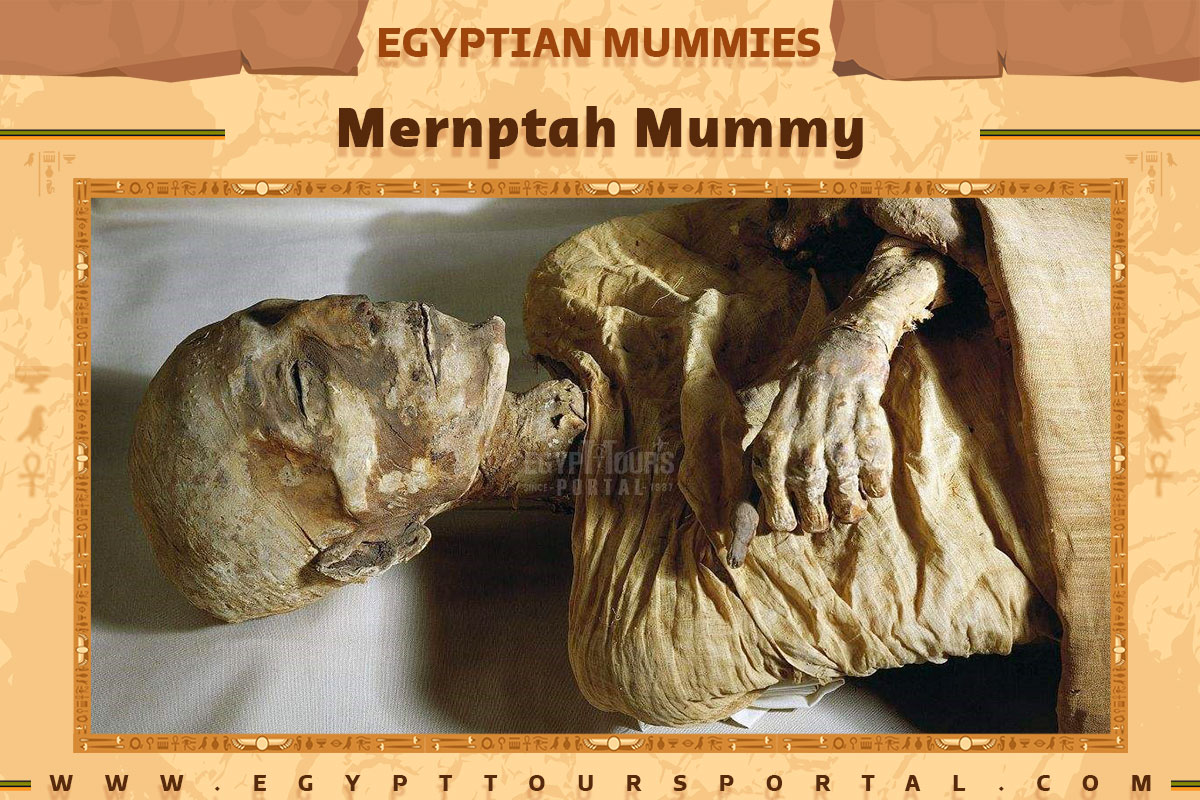
Merneptah, an ancient Egyptian ruler, experienced arthritis and atherosclerosis during his nearly decade-long reign. He passed away as an elderly individual. Initially interred in tomb KV8 in the Valley of the Kings, his mummy wasn't located there. In 1898, it was discovered, along with 18 other mummies, in a mummy cache within Amenhotep II's tomb (KV35). Eventually, the mummy was taken to Cairo and unwrapped on July 8, 1907. Smith's examination revealed that Merneptah was an old man, standing at 1.714 meters (approximately 5 feet 6 inches) in height. His head was mostly bald, with a small fringe of white hair on the temples and occiput, along with short black hairs on the upper lip and closely clipped hairs on the cheeks and chin. While his facial appearance bore a resemblance to Ramesses II, his cranial shape and facial measurements were more similar to his grandfather, Seti the Great.
In 1980, X-ray analyses on the cranial and skeletal remains of New Kingdom Pharaohs, including Merneptah's mummy were conducted and their findings highlighted notable similarities between the rulers of the 19th and 20th Dynasties and Mesolithic Nubian samples. They also observed connections with modern Mediterranean populations of Levantine origin. Harris and Wente suggested that these resemblances indicated a blend of northern origin among the Rammessides. In April 2021, his mummy was transferred from the Museum of Egyptian Antiquities to the National Museum of Egyptian Civilization during the Pharaohs' Golden Parade.
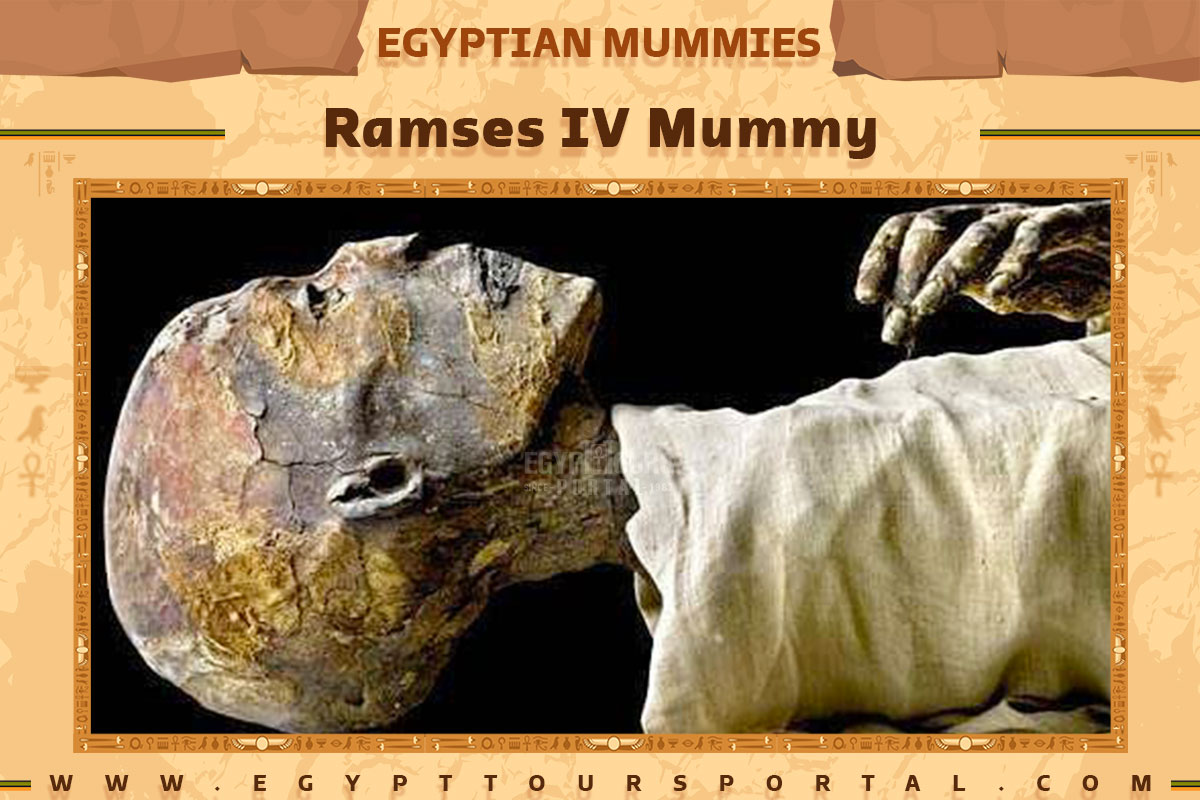
Following a brief reign lasting approximately six and a half years, Ramesses IV passed away and was laid to rest in tomb KV2 located in the Valley of the Kings. His mummy was discovered in the tomb cache of Amenhotep II's KV35 in 1898. His primary spouse, Queen Duatentopet or Tentopet, found her final resting place in QV74.
His throne was subsequently taken over by his son, Ramesses V. Initially, a tomb designated as QV53 had been constructed in the Valley of the Queens for Ramesses IV. In April 2021, his mummy was transferred from the Museum of Egyptian Antiquities to the National Museum of Egyptian Civilization, joining the remains of 17 other kings and 4 queens as part of the Pharaohs' Golden Parade.
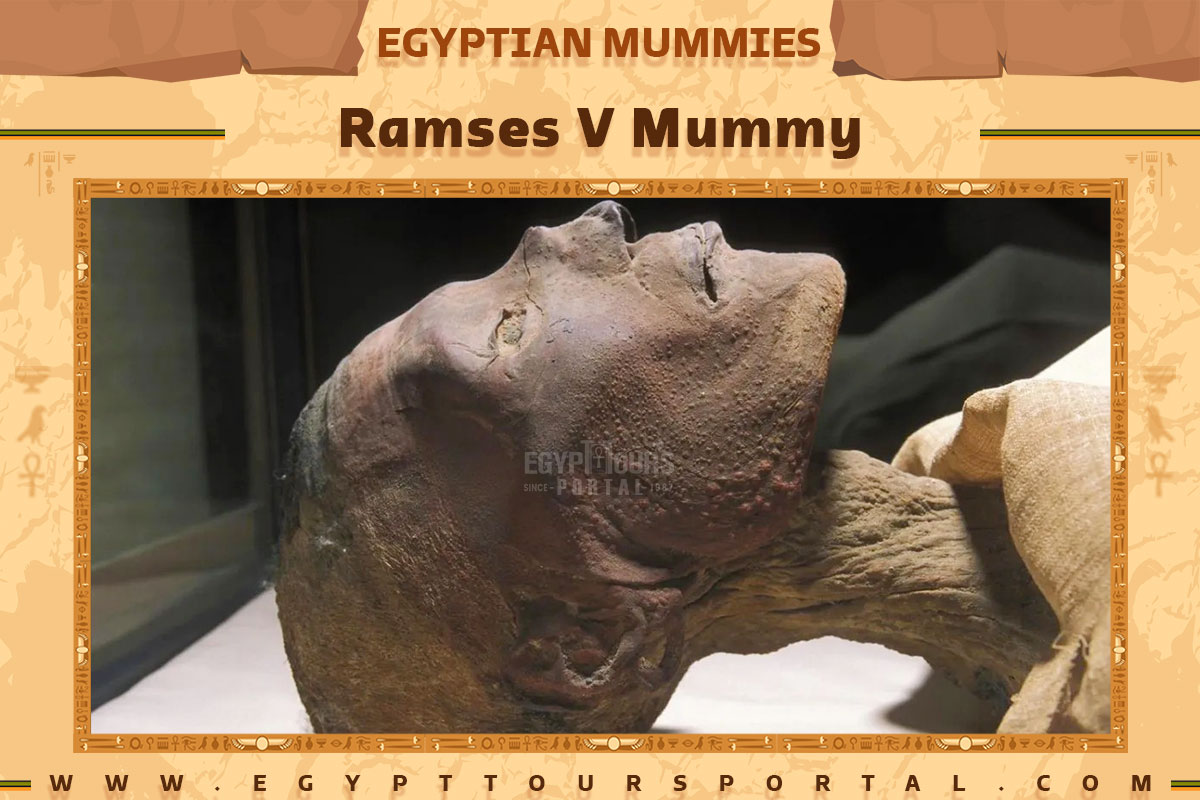
Ramesses V's death circumstances remain uncertain, though his reign lasted nearly four years. An unusual fact is that he was buried only in the second year of Ramesses VI, which deviated from Egyptian tradition dictating a king's burial within 70 days of their successor's reign. In 1898, Ramesses V's mummy was found, displaying facial lesions suggesting he suffered and potentially died from smallpox.
This condition made him among the earliest known victims of the disease. While a 2016 study traced smallpox's shared ancestral form to 1580 AD, it mainly demonstrated that strains of smallpox eradicated in the 20th century emerged around the late 16th century, during a period of rising human movement, population expansion, and increasing inoculation and vaccination practices.
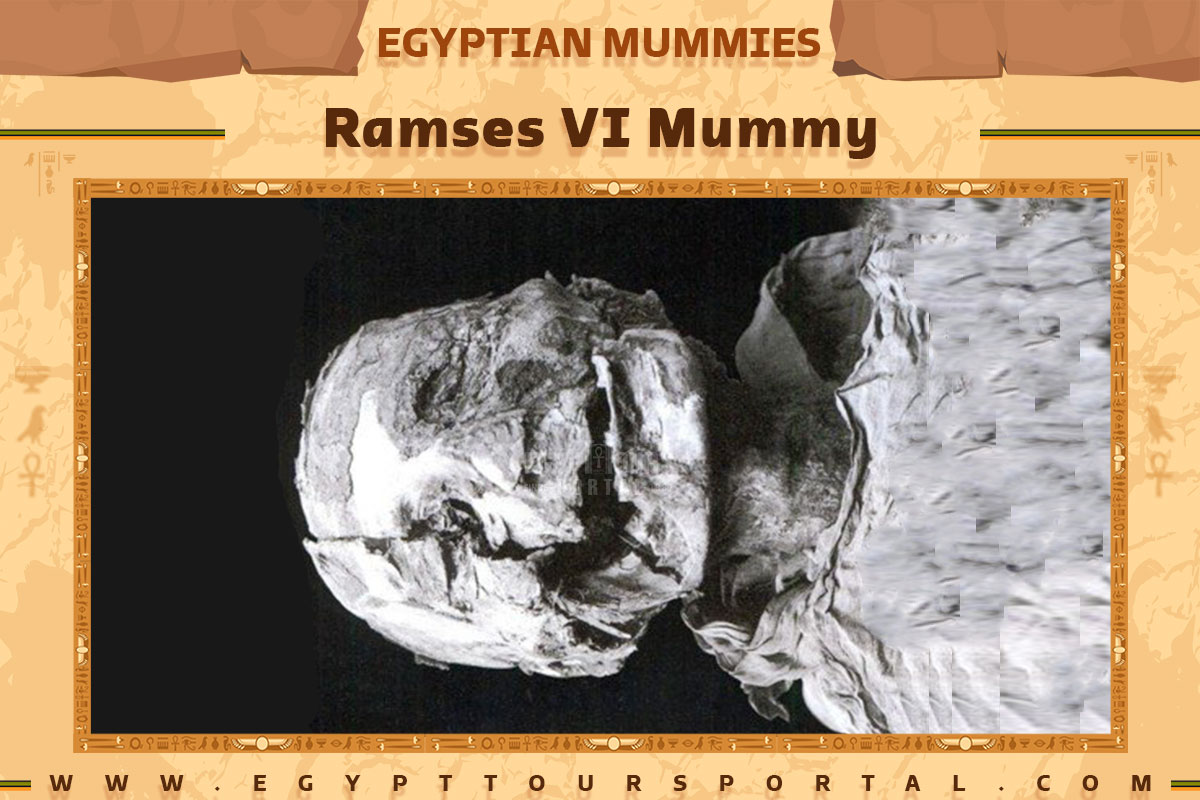
Pharaoh Ramesses VI was interred in the Valley of the Kings, specifically in tomb KV9, Ramesses VI's mummy was relocated to Amenhotep II's tomb (KV35) during the early Twenty-First Dynasty, discovered by Victor Loret in 1898. Medical analysis revealed he died around age forty and suffered severe body damage, including fragmentation of the head and torso due to the tomb robbers' axes. In 1898, researchers uncovered fragments of a large granite box and pieces of Ramesses VI's mummiform stone sarcophagus.
The sarcophagus in ancient Egypt was essentially a coffin designed to encase the mummified bodies of the deceased. Find out more intriguing facts!
Read MoreThe sarcophagus face, now in the British Museum, was restored in 2004 after meticulous work on over 250 recovered fragments. Despite efforts, requests to return the sarcophagus face to Egypt were unsuccessful. In 2020, the Egyptian Tourism Authority released a comprehensive 3D model of the tomb, featuring detailed photographs, available online. In April 2021, Ramesses VI's mummy was transferred from the Egyptian Museum to the National Museum of Egyptian Civilization, as part of the Pharaohs' Golden Parade, alongside 17 other kings and 4 queens.
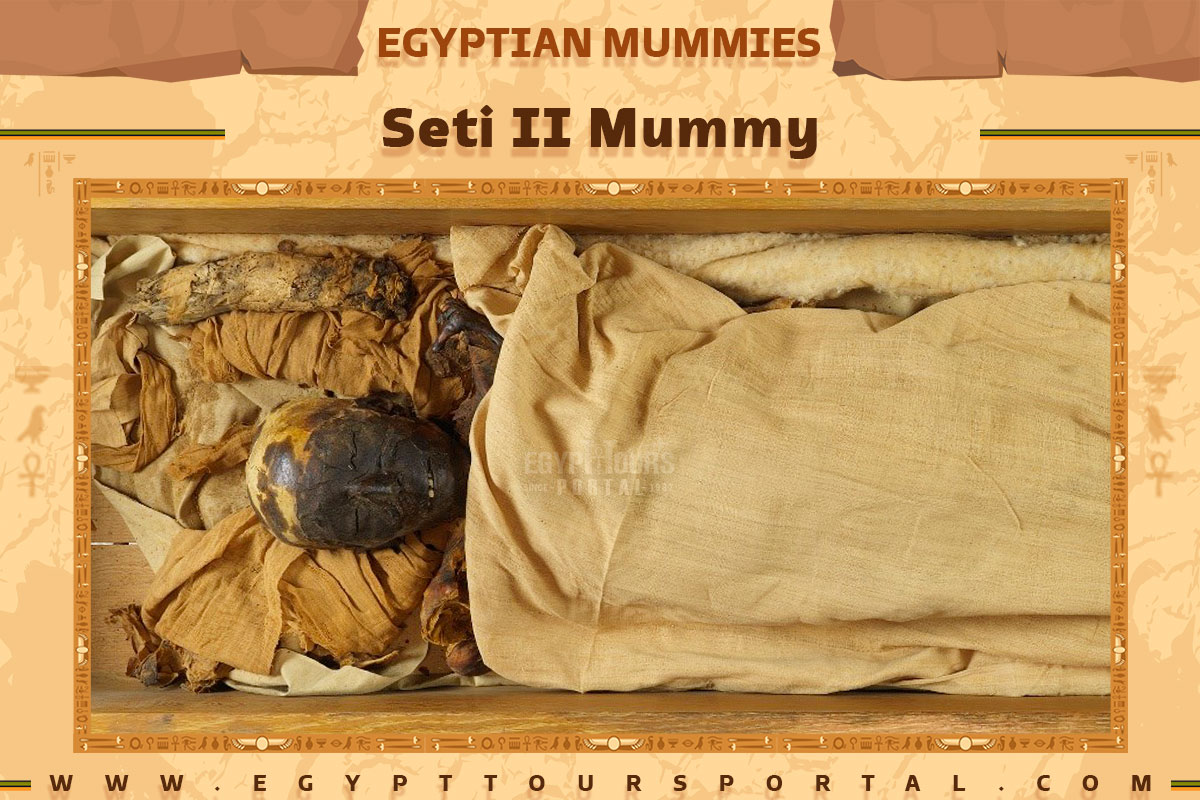
In 1980, a series of highly revealing X-ray examinations were conducted on the cranial and skeletal remains of New Kingdom Pharaohs, including the mummified remains of Seti II. Their analysis revealed significant similarities between the rulers of the New Kingdom's 19th and 20th Dynasties and Mesolithic Nubian samples.
They also identified resemblances with modern Mediterranean populations of Levantine origin. researchers proposed that these findings indicated a blending of populations, considering the Rammessides' northern origins. In April 2021, Seti II's mummy was relocated from the Museum of Egyptian Antiquities to the National Museum of Egyptian Civilization in an event known as the Pharaohs' Golden Parade.
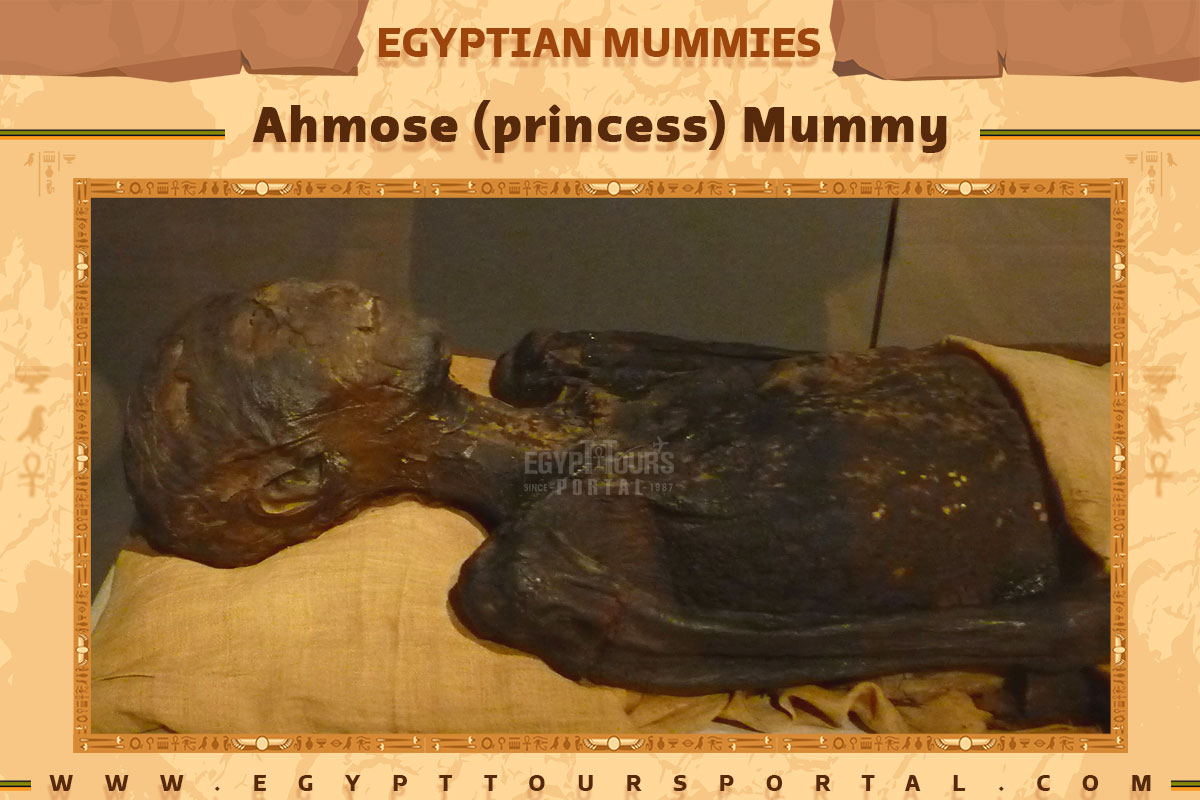
Ahmose was laid to rest in tomb QV47, situated within the great Valley of the Queens. This tomb is believed to be the earliest one constructed in that valley. It features a relatively simple design, comprising a single chamber and a burial shaft. Positioned within a marvelous subsidiary valley named the Valley of Prince Ahmose, her burial place is marked.
Princess Ahmose's mummy was uncovered during the excavations made between 1903 and 1905. Currently, her mummy is housed at the Egyptian Museum in Turin, Italy. Alongside the mummy, They discovered several funerary items, including a segment of her coffin, fragments of linen inscribed with roughly 20 chapters of the Book of the Dead, and leather sandals. All these artifacts are preserved in Turin.
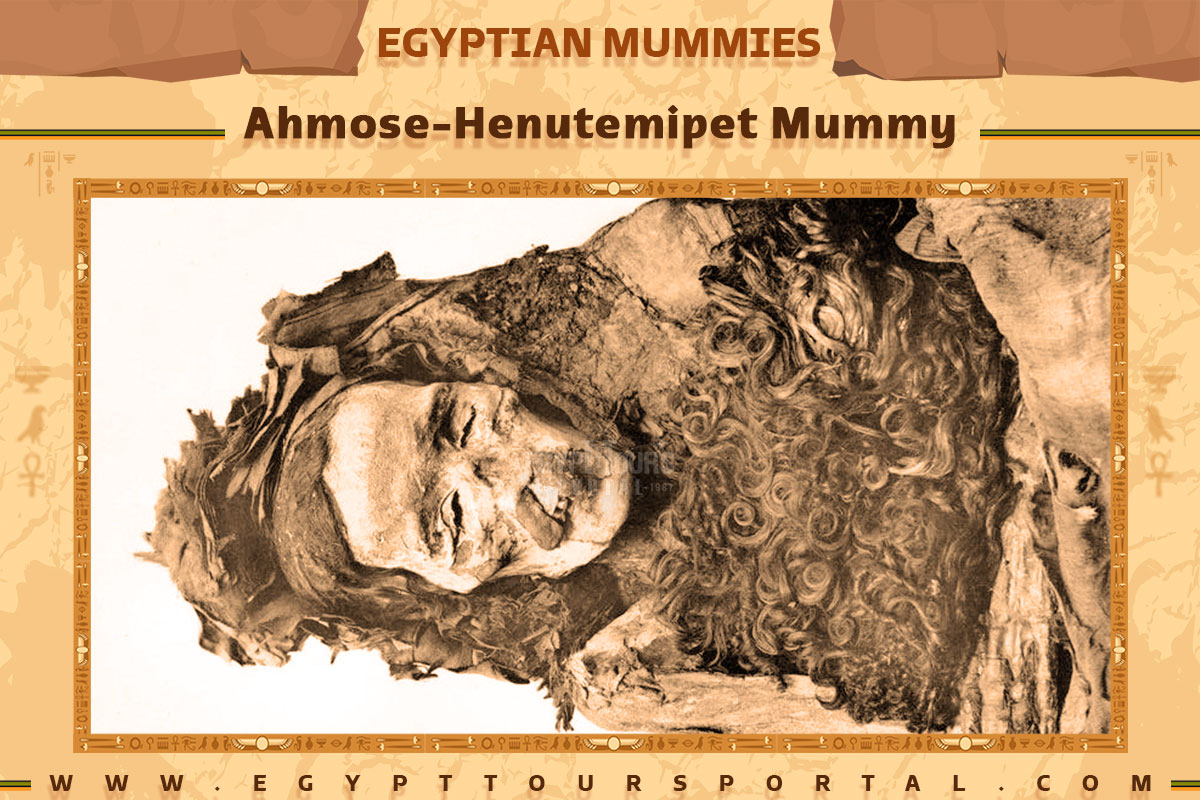
Ahmose-Henutemipet was a princess from the late 17th Dynasty of Egypt who was the daughter of Pharaoh Seqenenre Tao and Queen Ahhotep I, plus Ahmose I’s sister. She held the titles of King's Daughter and King's Sister.
Her mummy was discovered in 1881 and was examined in June 1909, revealing that Henutemipet died in her old age, displaying worn teeth and grey hair. Unfortunately, her mummy had been damaged, likely due to tomb robbers. It's probable that the mummy was relocated to tomb DB320 after the 11th year of Pharaoh Shoshenq I's reign.
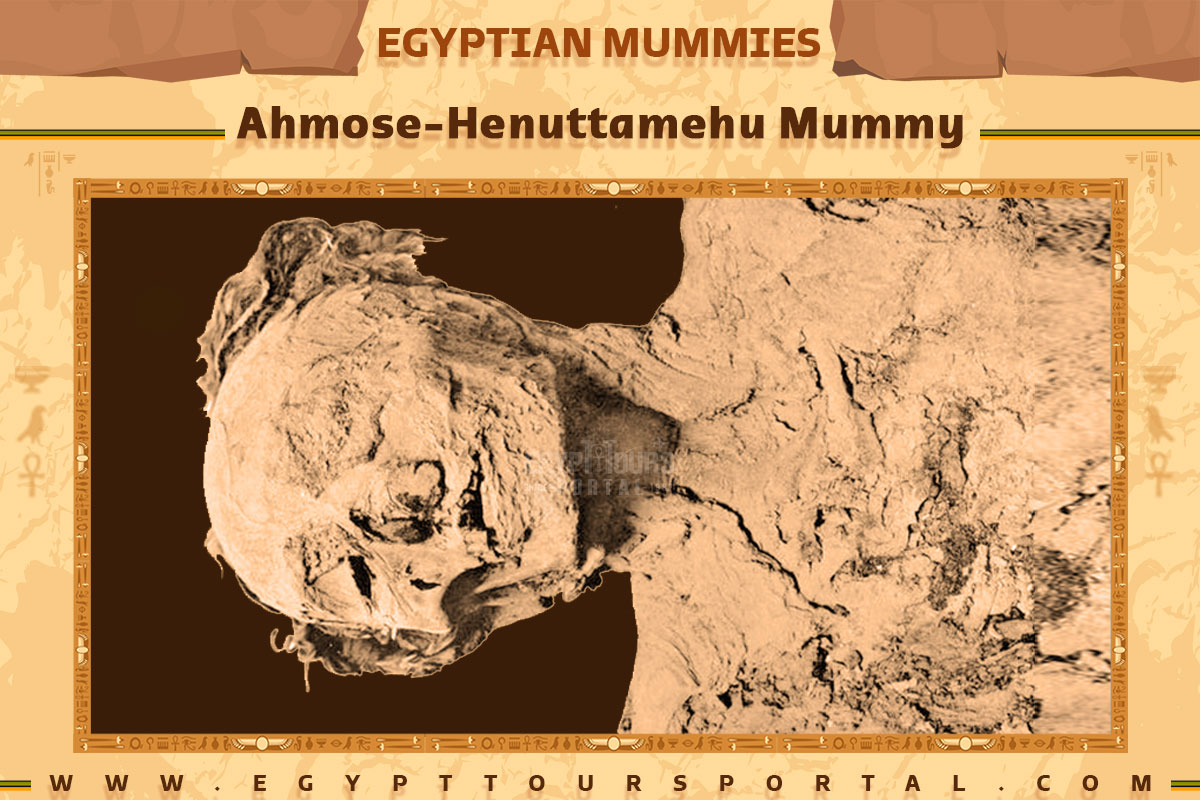
Ahmose-Henuttamehu's mummy was found within her own coffin in her tomb in Deir el Bahri in 1881. Gaston Maspero examined it in December 1882, revealing that she died as an elderly woman with worn teeth. Her mummy's bandages bore quotes from the Book of the Dead. It's likely she was interred alongside her mother.
After Year 11 of Pharaoh Shoshenq I's reign, her mummy was moved to her tomb along with other remains. Ahmose-Henuttamehu is honored among the ancestral figures revered in the Nineteenth Dynasty. She's depicted in the tomb of Khabekhnet in Thebes, positioned as the fourth woman from the left in the top row. The depiction includes Prince Ahmose-Sipair and other prominent figures.
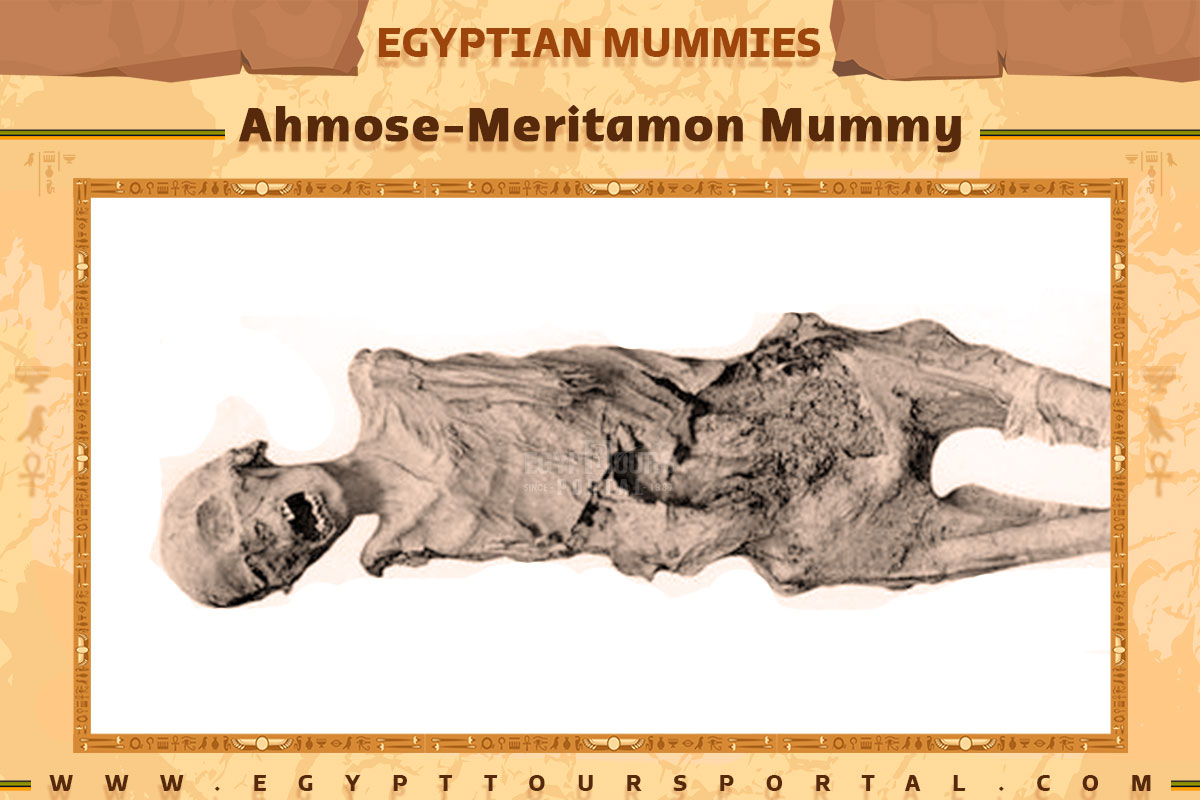
The mummy of Ahmose-Meritamun had undergone meticulous rewrapping during Pinedjem I's reign. Inscriptions reveal that the linen employed in this reburial was crafted in Pinedjem's 18th year, and created by the High Priest of Amun, Masaharta, who was Pinedjem I's son.
This reburial process occurred on the 28th day of the third month of winter in Pinedjem's 19th year. In April 2021, her mummy was transferred from the Museum of Egyptian Antiquities to the National Museum of Egyptian Civilization, marking the occasion known as the Pharaohs' Golden Parade.
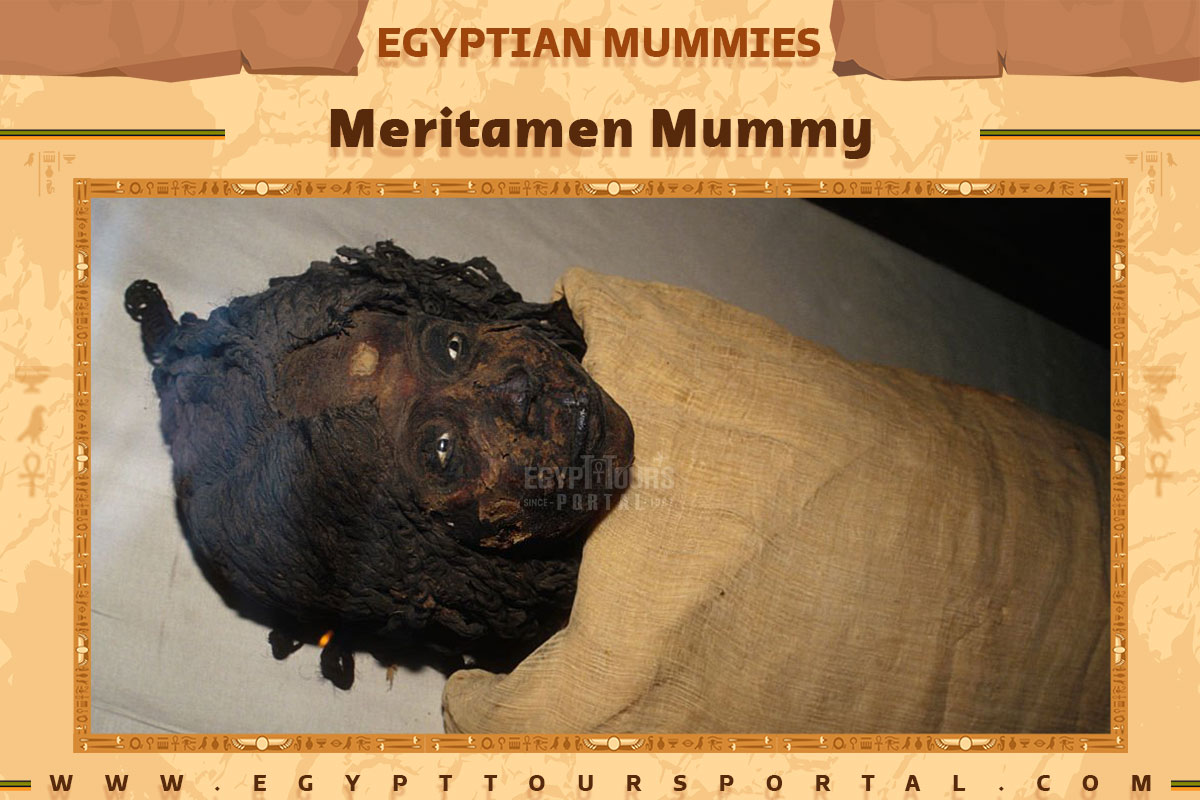
Queen Meritamen was the daughter and wife of Ramses the Great, She held many religious and royal titles, famous for her limestone statue found at the Ramesseum plus she appeared on the walls of the Abu Simbel temple with her family. Her mummy is found at the National Museum of Egyptian Civilization.
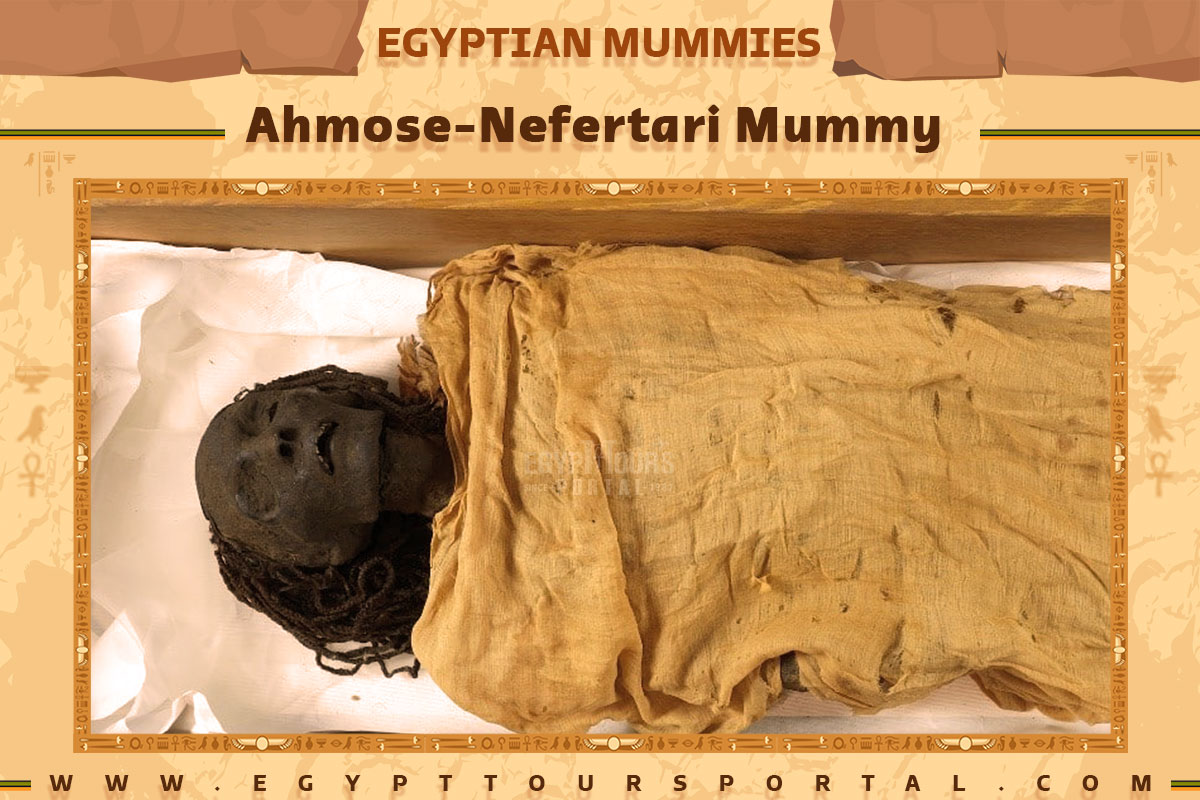
Ahmose-Nefertari was an ancient Egyptian queen who lived during the New Kingdom period, specifically in the 16th century BCE. She was the wife of Pharaoh Ahmose I and the mother of Amenhotep I. Ahmose-Nefertari is renowned for her role in the early 18th Dynasty of ancient Egypt. Her mummy is found at the National Museum of Egyptian Civilization.
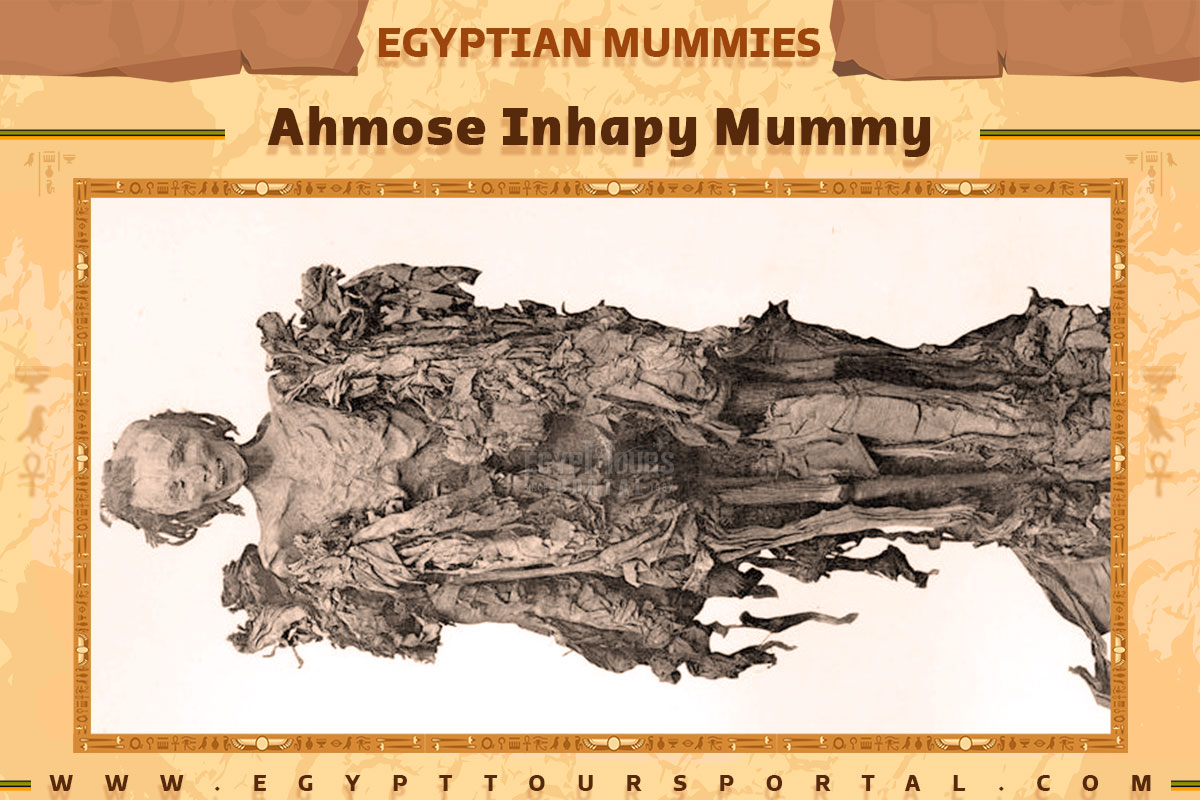
The mummy of Ahmose Inhapy is found in Thebes in Deir el Bahari where its discovery occurred in 1881. The mummy was located within the outer coffin of Lady Rai, who served as the main nurse of Inhapy's niece "Queen Ahmose-Nefertari". Gaston Maspero unwrapped the mummy on June 26, 1886. Inhapi is depicted as a robust, sturdy woman bearing a striking resemblance to her brother. It is estimated her burial to have taken place during the later years of Ahmose I's rule.
The mummy featured a floral garland around the neck and was positioned with arms at the side. Notably, the mummy's dark-brown skin retained an outer layer without any salt evidence, potentially differing from traditional preservation methods described in historical accounts. An incision on the left side suggests organ removal, possibly treated with natron, while aromatic powdered wood was scattered on the body before wrapping it in resin-soaked linen.
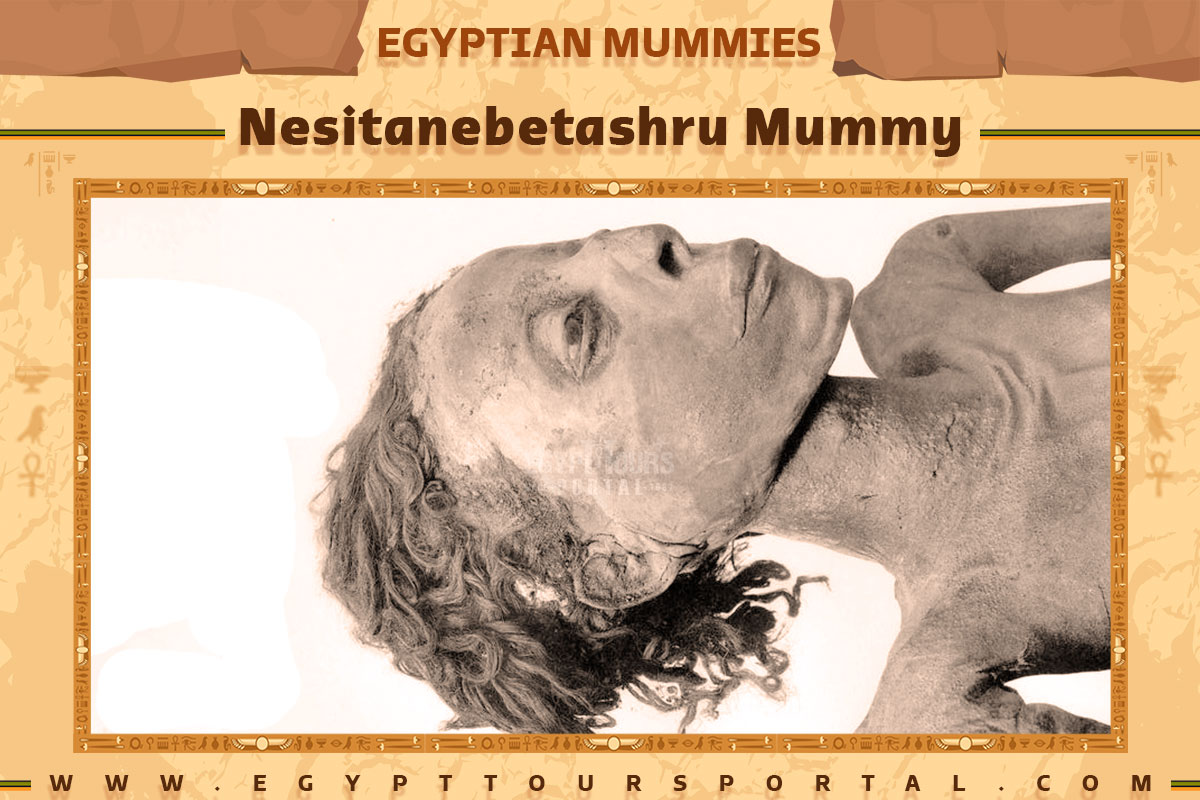
The name Nesitanebetashru pertains to two ancient Egyptian women associated with the title "Belonging to the Lady of the Ashru" which refers to the crescent-shaped sacred lake around solar goddess temples, specifically Mut. Nesitanebetashru from the 21st dynasty was the daughter of Pinedjem II who acted as the High Priest of Amun, and Neskhons. She's cited in her mother's funeral text inscribed on a wooden tablet.
Nesitanebetashru's mummy, ushabtis, and coffins were discovered in tomb TT320 in Deir El Behari. Notably, her extensive Greenfield papyrus containing funeral text ranks among the longest known, held in the British Museum's collections. In the 22nd dynasty, another Nesitanebetashru was the wife of the High Priest of Amun, Shoshenq, and the mother of Pharaoh Harsiese A. She held the role of Amun Chantress and is referenced on a Bes statue. Initially, her husband was wrongly identified as Pharaoh Shoshenq II.
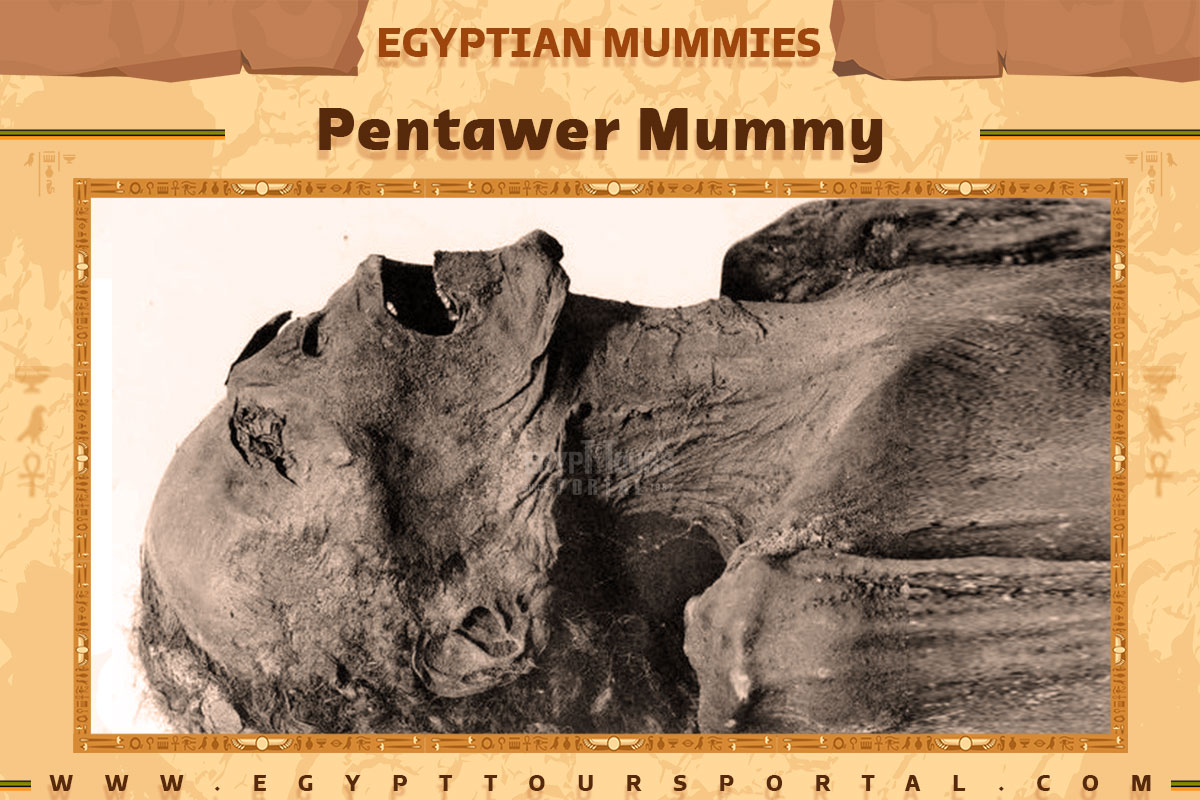
Recently, a number of skilled Egyptologist has revitalized the previous idea that the renowned mummy known as "Unknown Man E," discovered in the Deir el-Bahari cache, might indeed be Pentawer. This mummy stands out due to its unconventional embalming, which was done hastily without removing the brain and organs. It was then placed within a cedar box, which had to be crudely modified to accommodate it.
It's hypothesized that Pentawer could have been rapidly mummified and put in an available coffin, likely by a relative, to ensure he received a proper burial. Additional DNA analysis provides support for this theory, as it indicates that the mummy was a son of Ramesses, sharing both the paternal Y-DNA haplogroup E1b1a and half of their DNA.
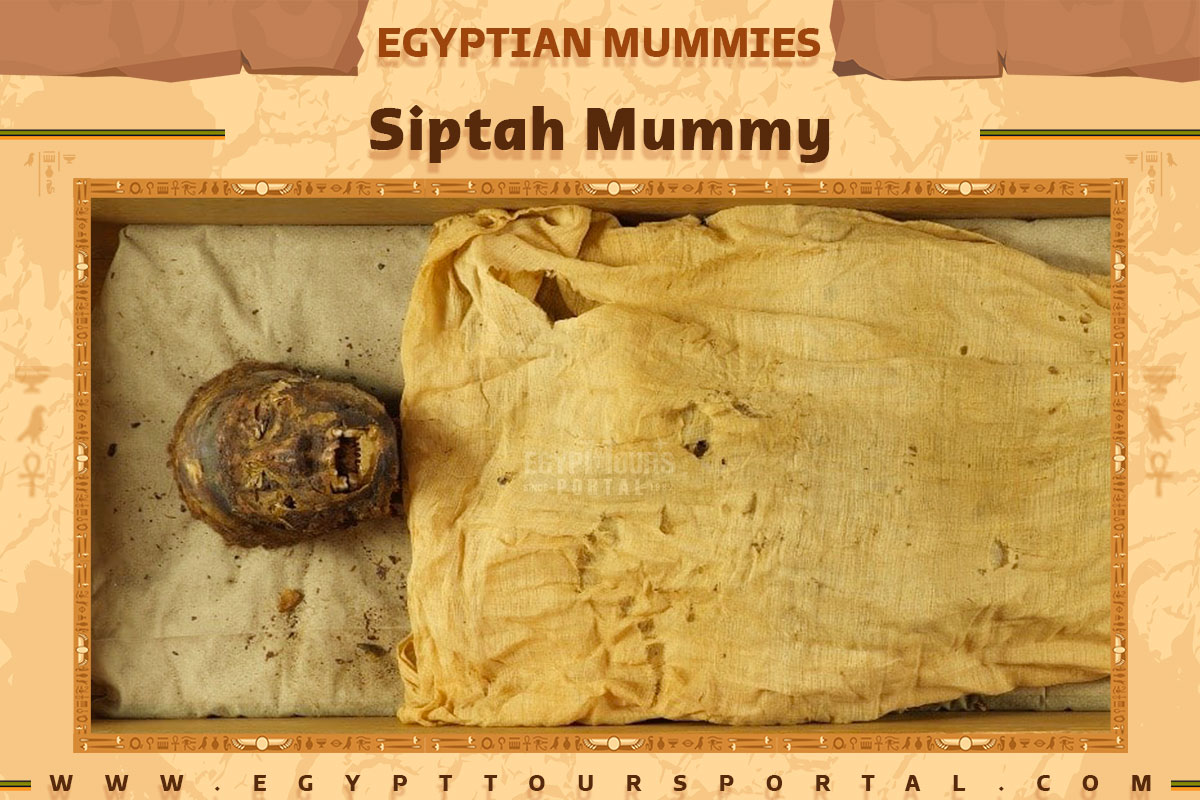
In 1980, researchers conducted a number of X-ray examinations on the remains of the New Kingdom of Egypt (1570 – 1050 BC) Pharaohs, including Siptah. The analysis revealed significant resemblances between the rulers of the 19th and 20th Dynasties of the New Kingdom and Mesolithic Nubian samples.
They also observed connections to modern Mediterranean populations from the Levant region. Harris and Wente proposed that this indicated a mixture of ancestry, given the northern origins of the Rammessides.
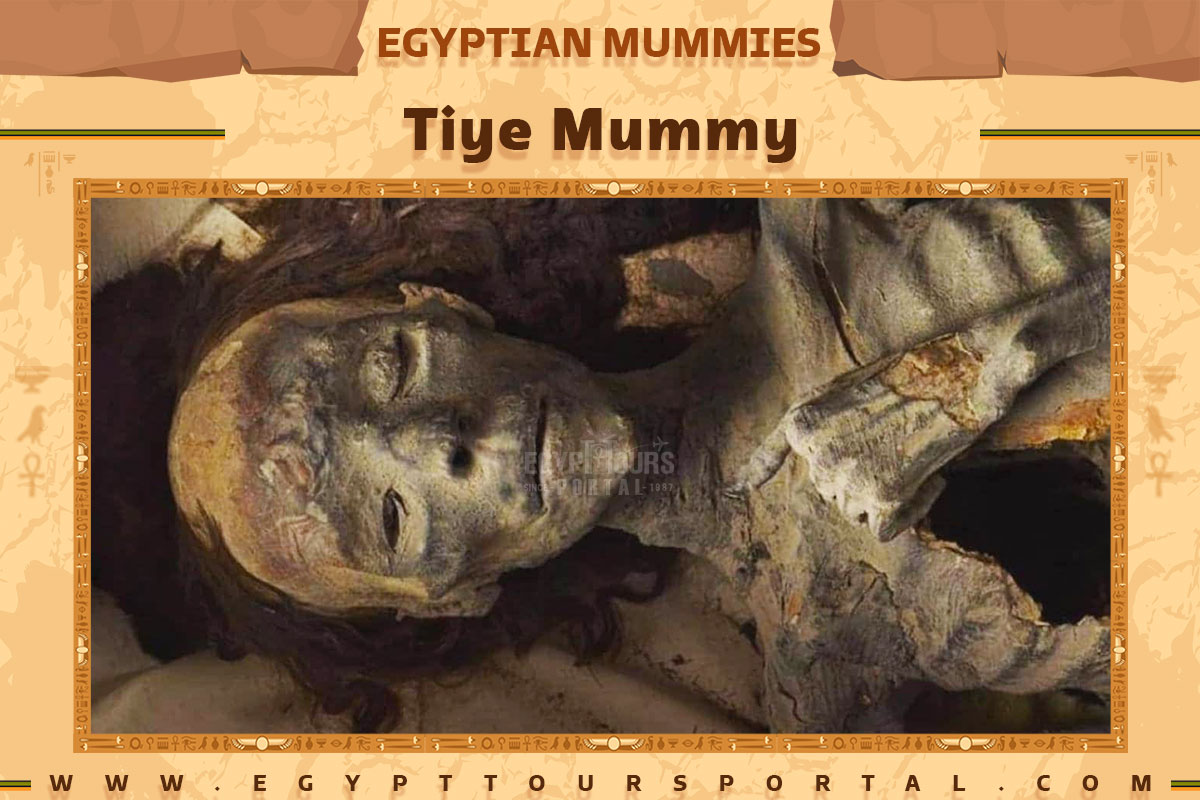
In 1898, three sets of mummified remains were discovered in a side chamber of Amenhotep II's tomb (KV35). They included an older woman, a young boy thought to be Webensenu or Prince Thutmose, and a younger unidentified woman. The older woman was initially known as the 'Elder Lady,' and the other as 'The Younger Lady'. Some researchers speculated that the Elder Lady was Queen Tiye, but skepticism existed, including from scholars like Aidan Dodson and Dyan Hilton. A set of miniature coffins with her name and hairlock was found in Tutankhamun's tomb. Microprobe analysis matched the hair with the Elder Lady's, identifying her as Tiye. X-ray examinations in 1980 indicated her craniofacial profile aligned with Mesolithic Nubians.
In 2010, DNA analysis confirmed the Elder Lady as Queen Tiye, about 40-50 years old at death and 145 cm tall. DNA results in 2020 unveiled her mtDNA haplogroup K, with Yuya, her father, having Y-DNA G2a and mtDNA K. In 2022, the analysis suggested a genetic affinity with Sub-Saharan Africans among the mummies. However, complexity is noted in biological heritage interpretation. DNA analysis discrepancies among research teams have led to uncertainty about the ancient Egyptians' genetic makeup and origins. In April 2021, her mummy was transferred from the Museum of Egyptian Antiquities to the National Museum of Egyptian Civilization in the Pharaohs' Golden Parade event.
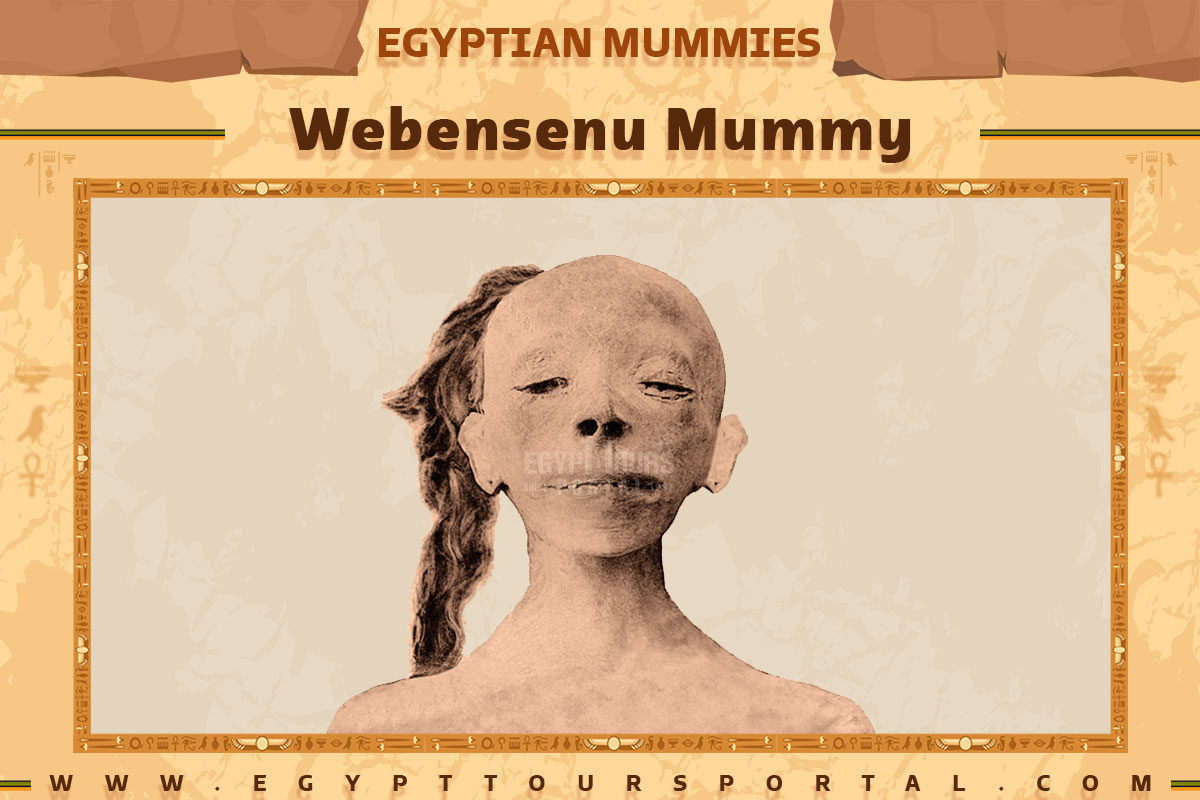
Webensenu, belonging to the Eighteenth Dynasty of ancient Egypt, held the title of prince. He was born as a son of Pharaoh Amenhotep II. Webensenu and his brother Nedjem are recorded on a statue of Minmose, who supervised works in Karnak. His life was tragically short, passing away as a child.
His final resting place might have been within his father's tomb, KV35, potentially sharing space with Tiye and the Younger Lady. Artifacts like canopic jars and habits connected to him were also unearthed within the tomb. His presumed mummy remains in the tomb, hinting at his age of around ten at the time of his demise.
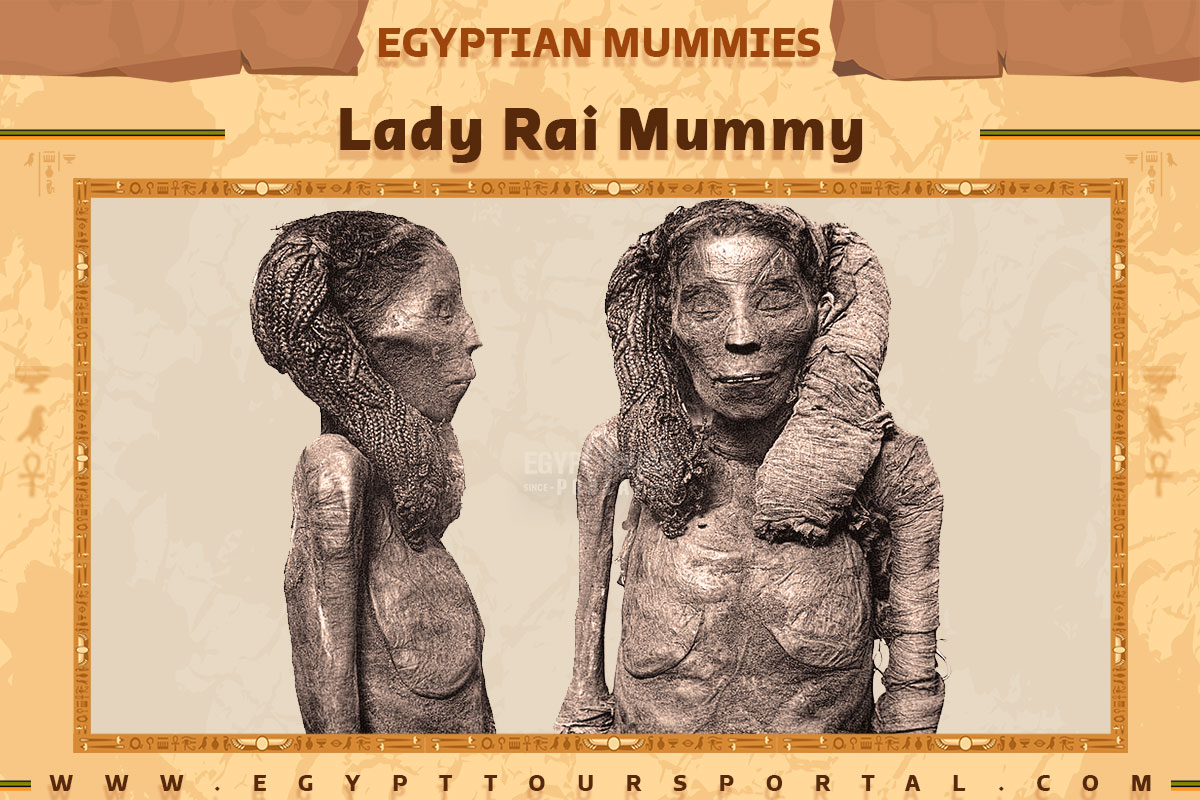
Lady Rai dates to the early 18th Dynasty and held the role of nursemaid to Queen Ahmose-Nefertari. In 1881, her mummified remains were found in a Theban tomb. She likely passed away around 1530 BC at an age of 30 - 40 years. The mummy was uncovered in 1909 who praised her embalming as a prime example from that era, noting her "Slim, gracefully-built" physique at 1.510 meters tall.
In 2009, a medical team's CAT scan disclosed that Lady Rai's mummy displayed a diseased aortic arch which makes her the oldest known mummy with atherosclerosis evidence. Interestingly, the mummy of Ahmose Inhapy was discovered within the outer coffin of Lady Rai.
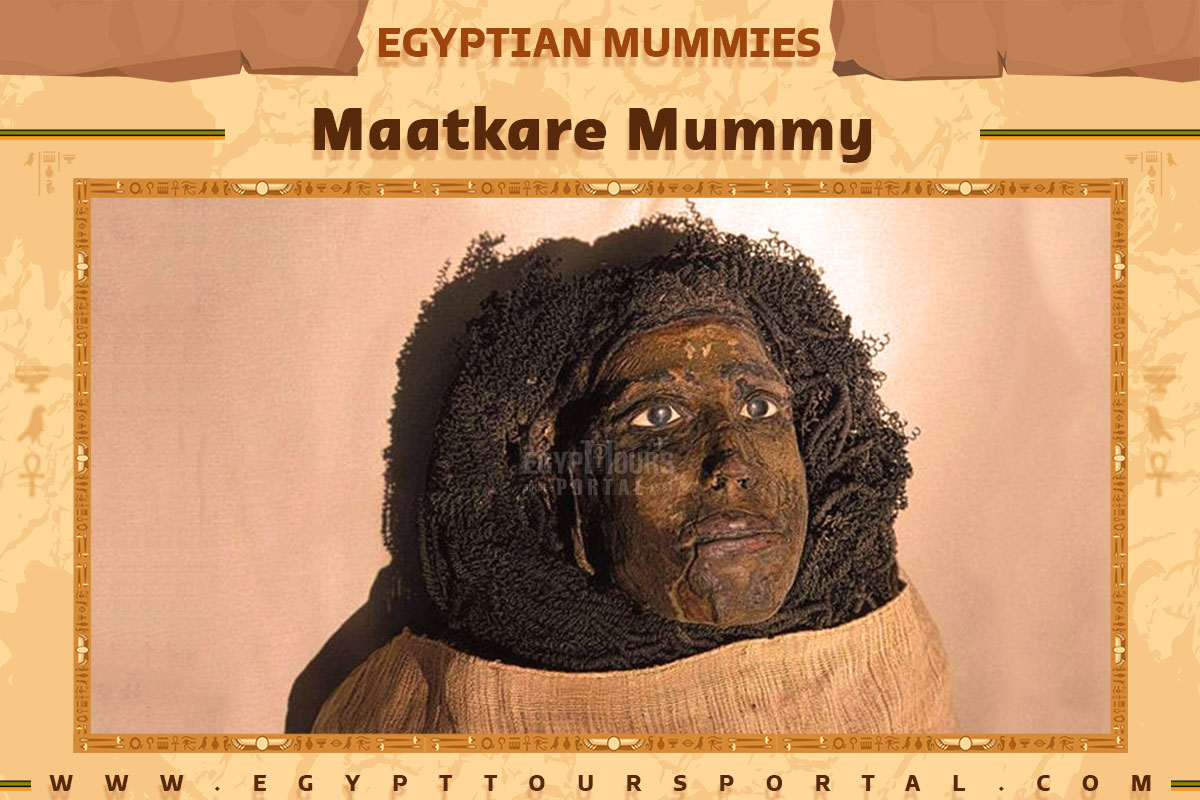
Maatkare (Mutemhat) was an esteemed figure in ancient Egypt, serving as a high priestess and God's Wife of Amun during the 21st Dynasty. While her original burial site remains unknown, her mummified remains, along with her coffins, Shawabtis, and the mummies of her close family, were discovered in the DB320 cache in Deir el Bahari.
Initially, a small mummy believed to be her child turned out to be that of a pet monkey, underlining the supposed celibacy of God's Wives.
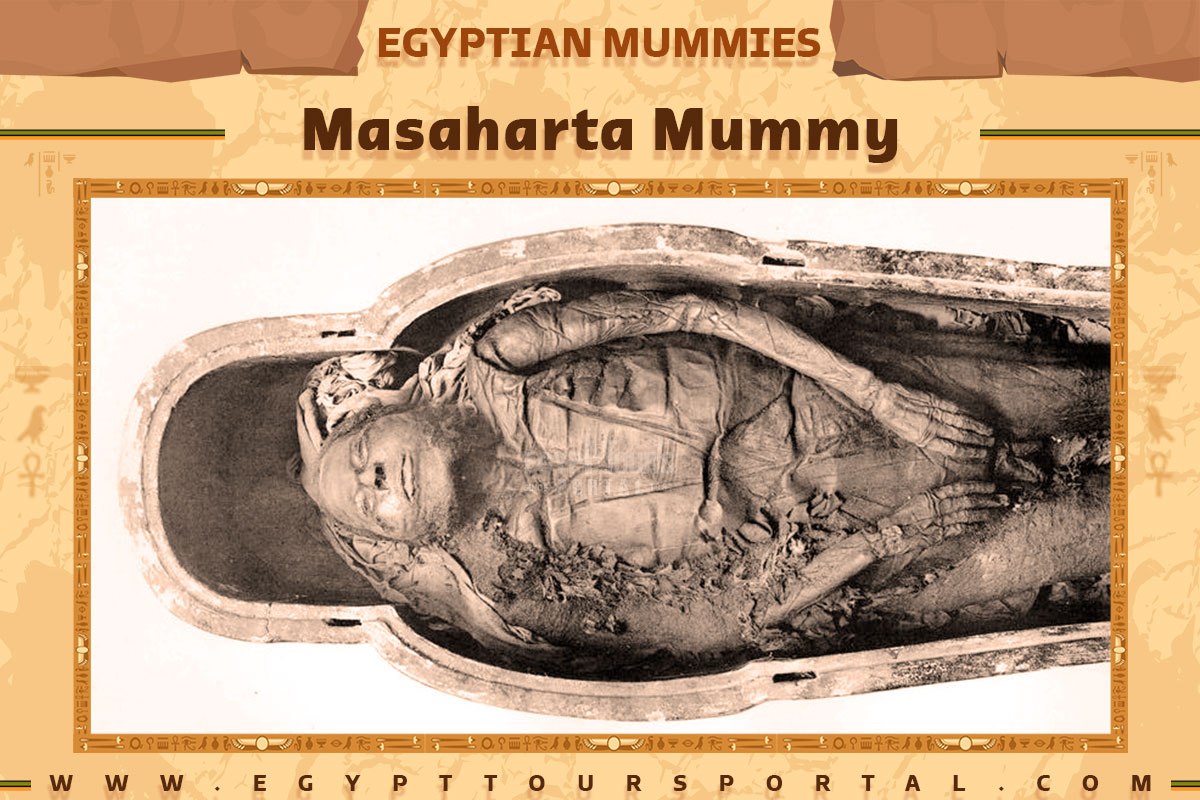
Masaharta was an ancient Egyptian high priest with a potential wife named Tayuheret and a possible daughter named Isetemkheb. He held the role of the God's Wife of Amun during his reign, with his sister Maatkare succeeding him in this position. Masaharta's inscriptions and statues can be traced to the Karnak temple of Amenhotep II and various locations.
Notably, he oversaw the restoration of Amenhotep I's mummy during Smendes' 16th regnal year. He is mentioned alongside Ankhefenamun in Theban. Although it is speculated that he might have passed away due to illness in el-Hiba during Smendes' 24th regnal year, this theory lacks concrete evidence. His mummy, discovered in the Deir el-Bahri cache alongside family members, is currently housed in the Mummification Museum in Luxor.
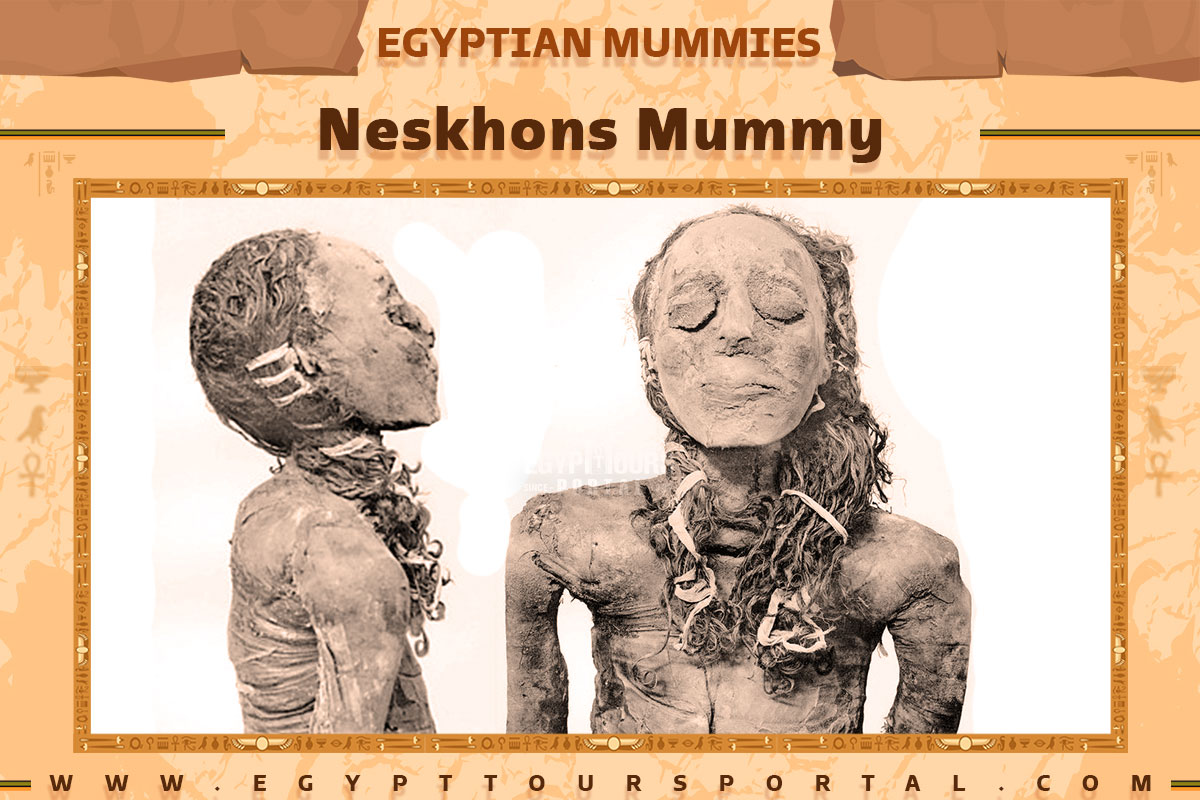
"Neskhonsou" was a noblewoman from the 21st Dynasty of Egypt, who had her mummy partly unwrapped by Gaston Maspero in 1886. She held esteemed titles like First Chantress of Amun and King's Son of Kush. Despite her young age, her mummy lacked gray hair, indicating her youthfulness.
She might have been pregnant or giving birth when she died. The gold embellishments on her coffin were stolen in antiquity, and her heart scarab was taken by grave robbers but later recovered and now resides in the British Museum.
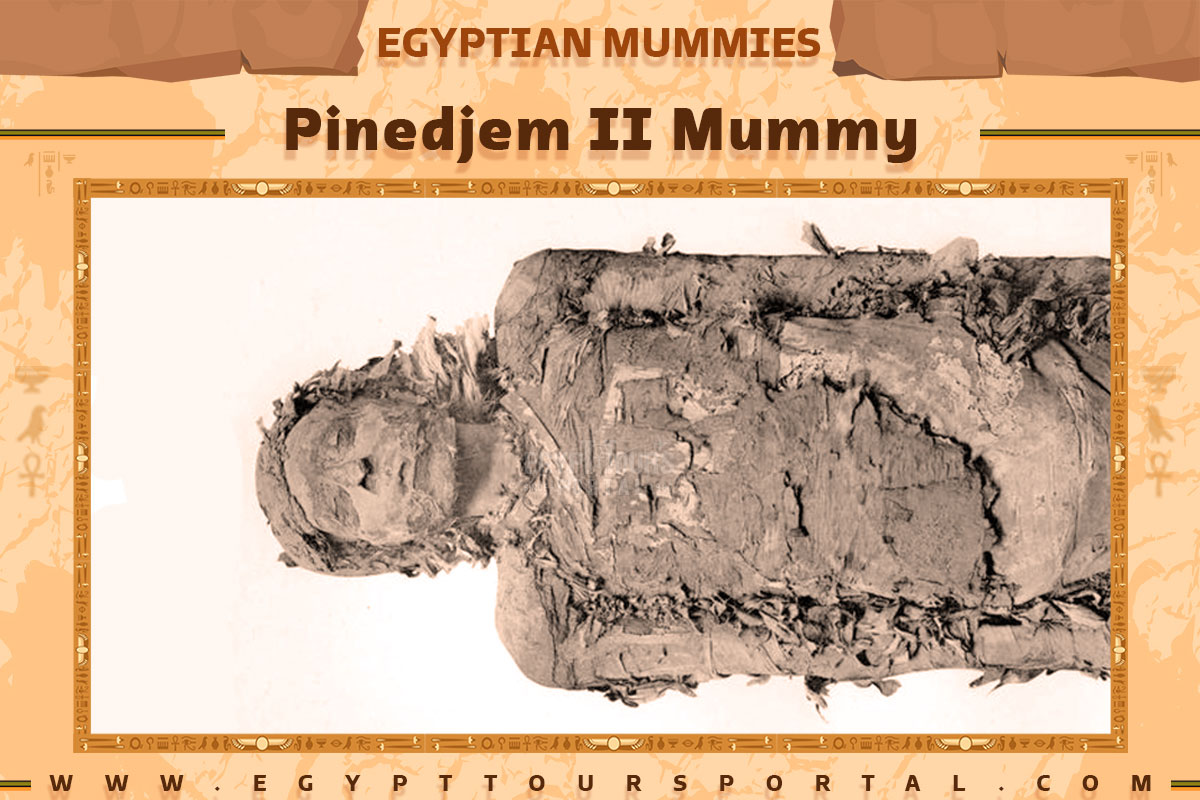
Pinedjem II served as High Priest of Amun from 990 BC to 969 BC, essentially controlling the southern region. Upon his death, he, his wives, and possibly one daughter, Nesitanebetashru, were buried in a tomb at Deir el-Bahri, above Hatshepsut's Mortuary Temple.
The tomb's discovery occurred in 1881. In the future, other rulers were also laid to rest there. This collective interment aimed to safeguard their remains from tomb robbers who had plundered their graves in the past.
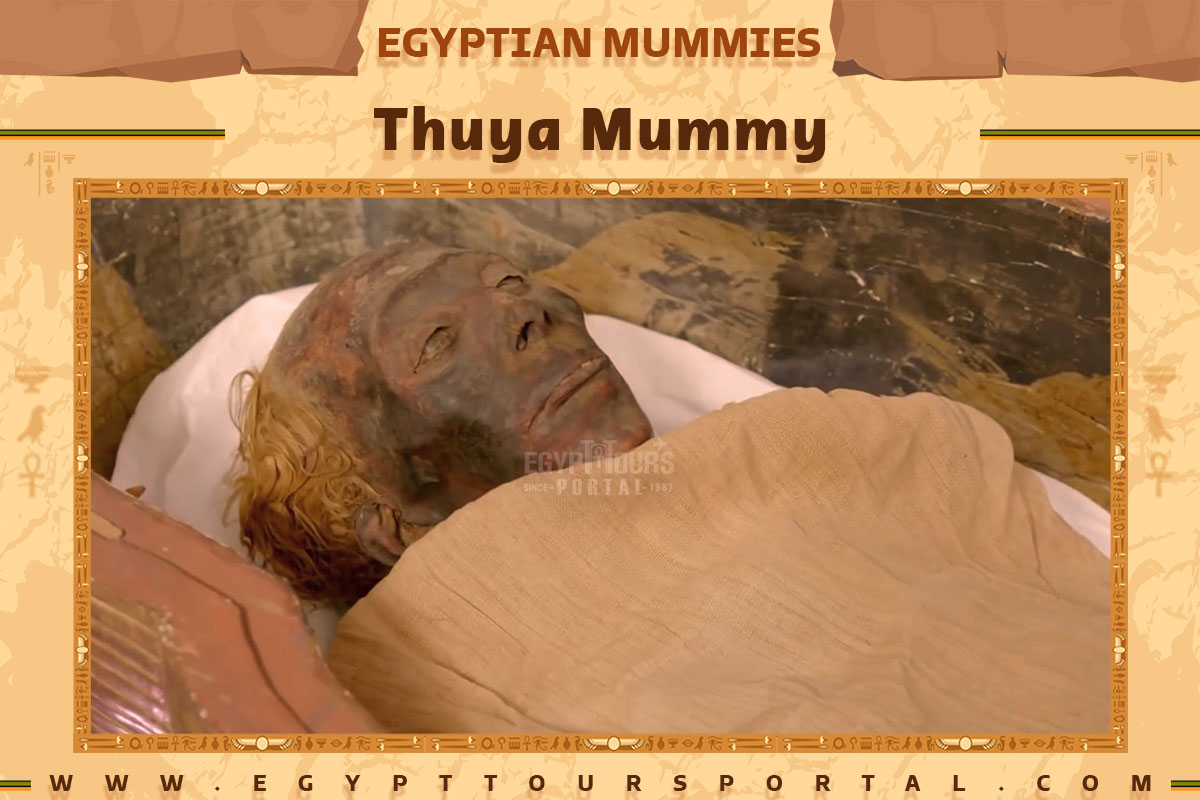
Thuya's mummified body was discovered wrapped in linen and secured by bandages coated with resin. Gilded titles from gold foil adorned the bandages, revealing her status. The examination led by Grafton Elliot Smith described her as an elderly, small-statured woman measuring 1.495 meters (4.90 feet) in height. She had white hair and two piercings in each earlobe.
The arms were straight at her sides, and her hands rested on her thighs. Her body was filled with resin-soaked linen, and carnelian beads were attached to her embalming stitches. Gold foil sandals adorned her feet. Douglas Derry, assisting Smith, noted her age as over 50, which CT scans later estimated to be 50-60 years old. Her brain was removed, her nostrils stuffed with linen, and her face filled to appear lifelike. Dental issues were evident, and mild scoliosis was detected. The cause of death remains unknown.
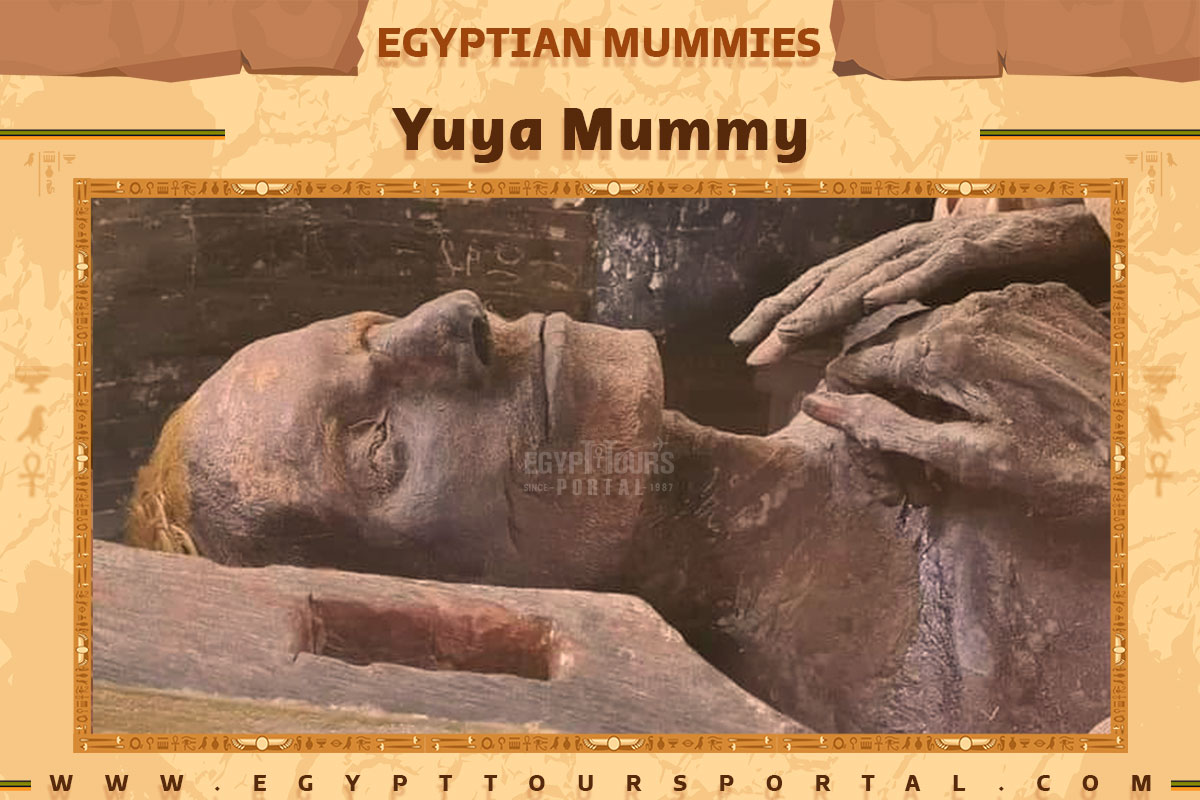
Yuya's mummy was discovered with his torso partially unwrapped, exposing his embalming incision covered by a gold plate. Robbers had missed the plate but dislodged a necklace, leaving it behind his neck. His head wrappings were later removed before transportation to Cairo. Grafton Elliot Smith's examination revealed Yuya as an elderly man with magical white wavy hair discolored by embalming, standing at 1.651 meters tall. His hands were placed under his chin, with a gold finger stall on his right little finger.
Linen packs were in his eye sockets and body cavity, with resin-treated packs in his mouth and under his skin for a lifelike appearance. CT scans estimate his age at death to be 50-60, showing great joint degeneration and tooth wear. Two layers of resin inside his skull were found, yet his cause of death remained undetermined. The positioning of sarcophagi suggested Yuya's interment as the first, although his funerary mask indicated he might have outlived his wife Thuya.
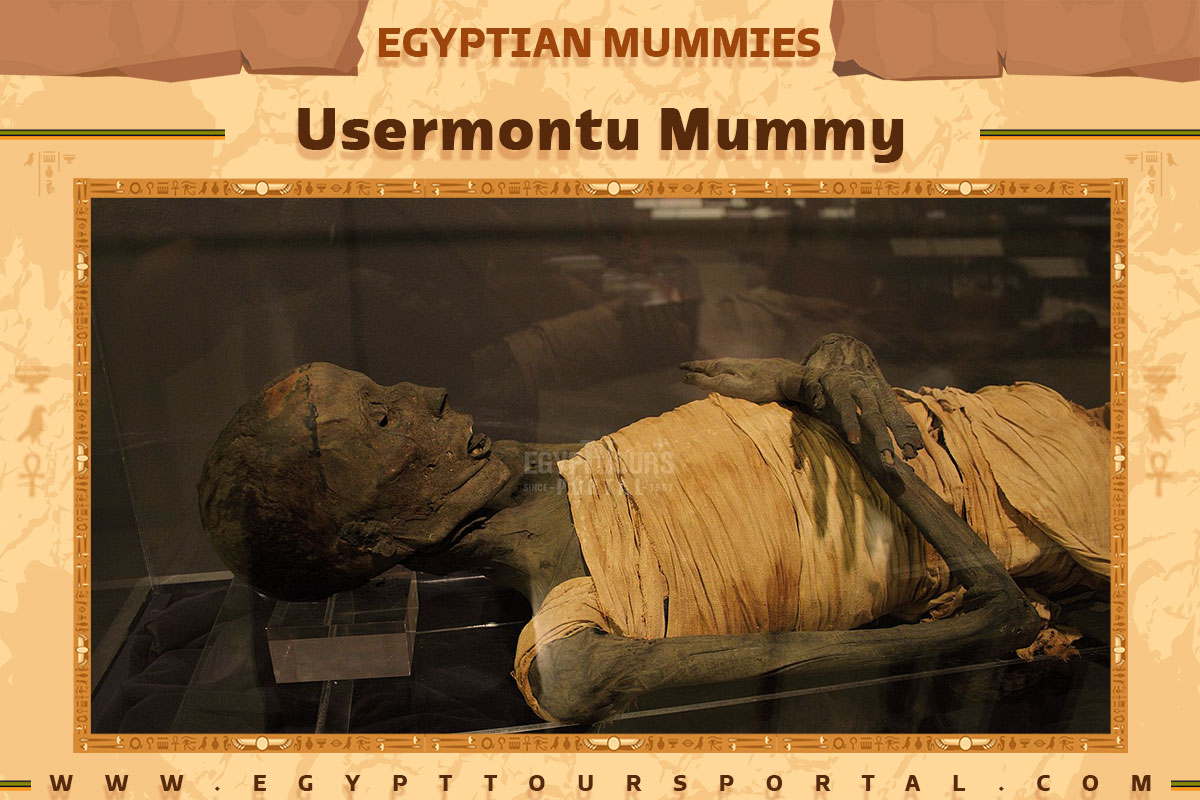
The Rosicrucian Egyptian Museum in San Jose, California, displays an ancient Egyptian mummy named Usermontu which means "Powerful is Montu". The mummy is well-preserved and stands out for having an ancient prosthetic pin in its left knee. The museum acquired two sealed Egyptian coffins in 1971, one of which contained the mummy. The embalming style suggests that the mummy was likely an upper-class Egyptian male from the New Kingdom period (16th–11th century BCE).
The body was placed inside the coffin of a different person, the "Real" Usermontu from the 26th Dynasty, around 400 BCE. The origin of the coffin and mummy is unknown. Notably, the mummy's left knee holds an ancient iron orthopedic screw, initially thought to be a modern addition. However, X-ray scans and further analysis revealed that the pin was inserted after the man's death but before burial, held in place by organic resin. This operation aimed to preserve the body's integrity for the ancient Egyptian afterlife beliefs.
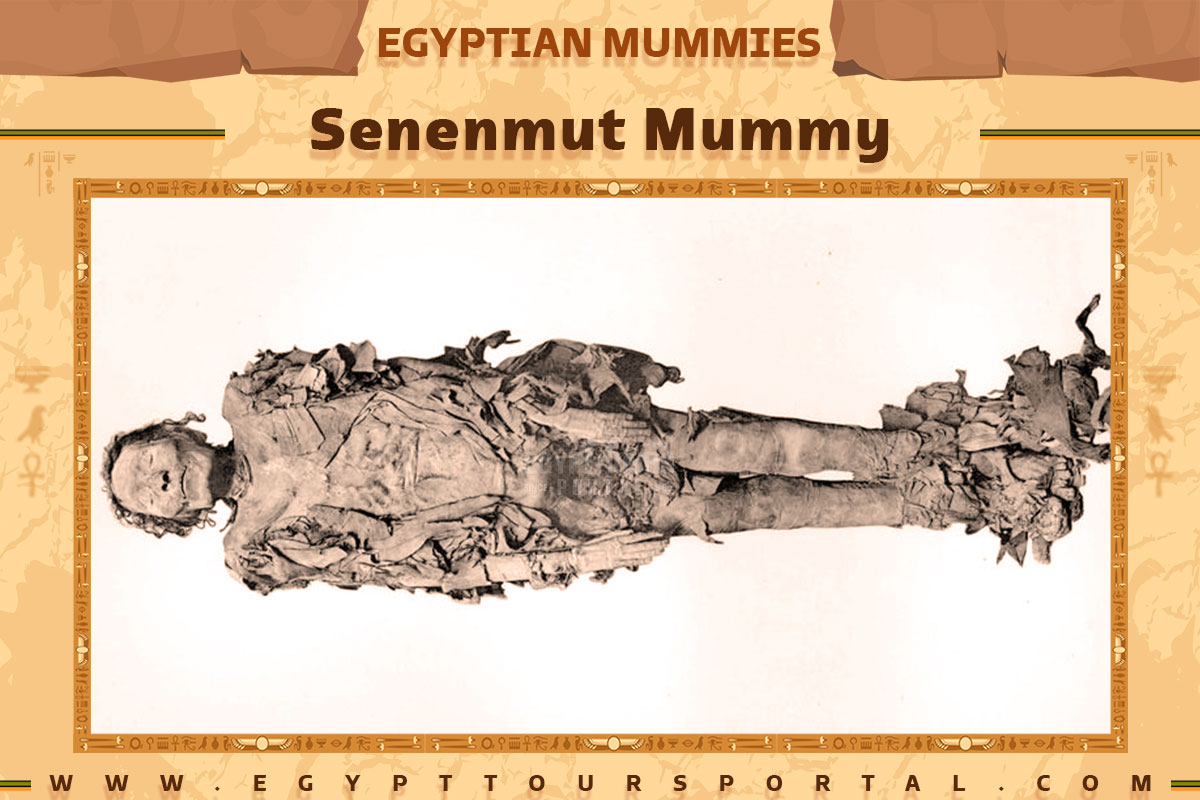
The search for Senenmut’s tomb has always been a mystery as his mummy was linked to the mummy of Queen Hatshepsut and he might have been buried with her because they could have been in love. The discovery of King Hatshepsut's remains has raised questions about the location of her courtier Senenmut's mummy. There's interest in using DNA from bone or teeth to identify him among unidentified royal mummies. The intact tomb of his parents Hatnofer and Ramose, was found in their son's courtyard. Senenmut's tomb was explored in 1936, revealing a smashed sarcophagus that some believe might not have been used by him.
The hope is that if the Egyptian sarcophagus was used, Senenmut's mummy wasn't inside during its destruction. DNA from Hatnofer and Ramose could identify him among unknown royal mummies, though the chances of finding him remain slim. Senenmut's father Ramose was found as a skeleton and was likely not mummified, while his mother was initially mummified but has since degraded, aiding DNA preservation. Among male mummies from cache tombs DB 320 and KV 35, a possible candidate is a mummy labeled "Unknown Man C". This mummy could belong to the early Thutmoside period, even during Hatshepsut's reign. A box with Hatshepsut's name was found in the king's cache, potentially related to her mummy's tooth discovery in KV 60. Senenmut had options for his burial, but his prominent tomb at Sheik Abd el-Qurna, where his parents were also buried, seems likely. There's speculation that he might have died before Hatshepsut and been buried in her tomb, with later removals by Thutmosis III.
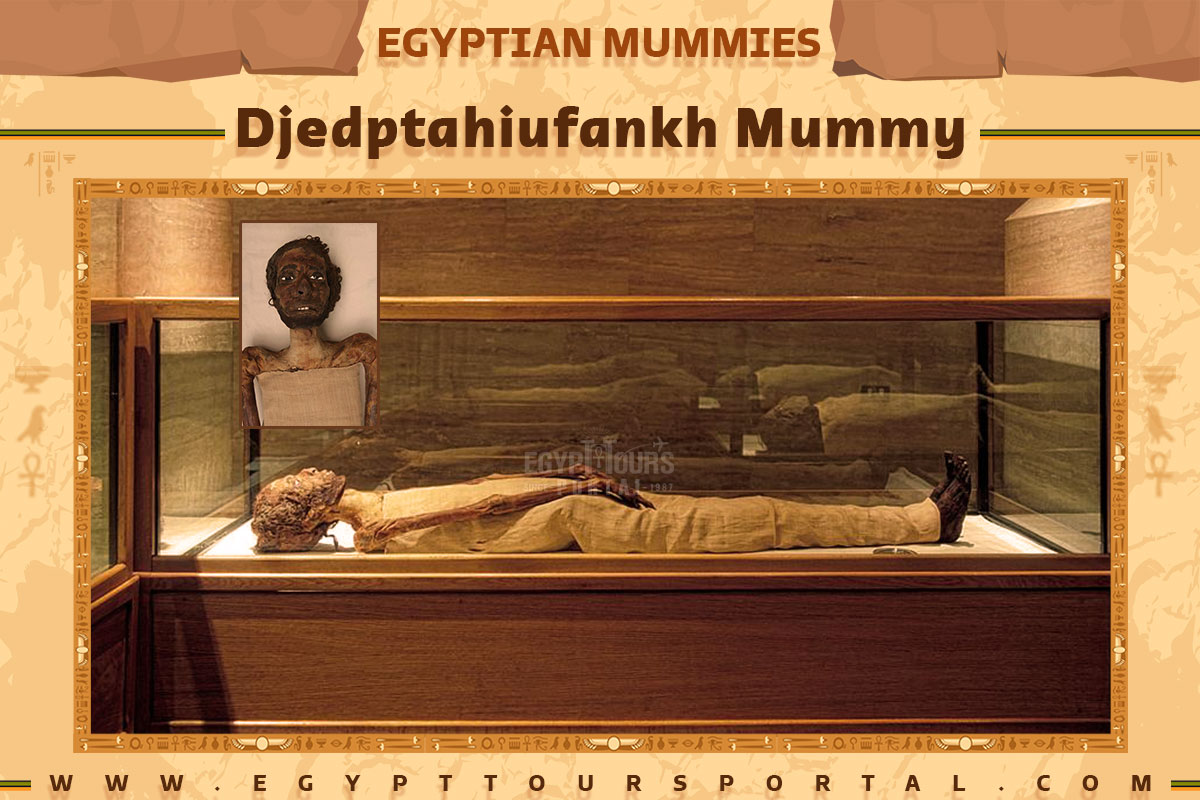
Djedptahiufankh (969 – 935 BCE) held positions as Second Prophet of Amun and Third Prophet of Amun during the reign of Shoshenq I of the 22nd Dynasty. Djedptahiufankh's death occurred around the middle of Shoshenq I's reign, as indicated by inscriptions on his mummy's wrappings. Djedptahiufankh's burial was well-preserved and included amulets, such as snake and lotus forms at the throat, a heart scarab on the chest, and stone amulets on the left arm.
Further examined the body in 1906, revealing additional stone amulets including a depiction of the baboon-headed god Hapi. A bronze embalming plate covered the incision used during organ removal. The mummified organs were placed within the body, accompanied by an amulet of Hapi. Thin gold rings adorned his fingers, potentially holding gold finger stalls in place.
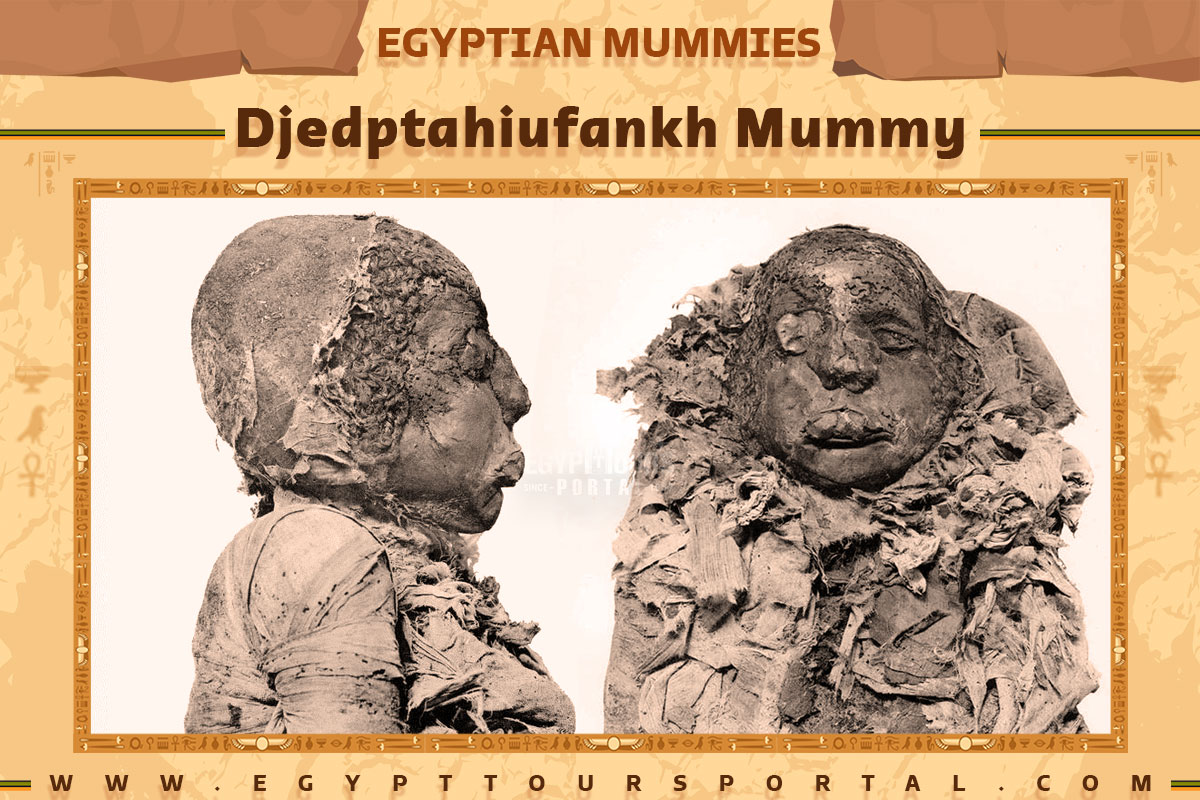
Tayuheret "1054-1046 B.C." was the wife of High Priest Masaharta, and similarities in their coffins suggest a close relationship. She's believed to be the mother of Isetemheb as proven by her white hair indicates she lived a long life. Her mummification was poorly executed, leading to facial distortion.
Wax was used to prevent distortion, and she had a wax nose guard, stone eye, and wig covering her ears. Insect damage affected her forehead, similar to Maatkare and Duathathor-Henttawy-A's mummies. Tayuheret's body was documented in "The Royal Mummies," and modern CT scans were used to assess her mummification quality. Her mummy, discovered in Tomb DB 320, chamber F, was found alongside Masaaharta and Maatkare Mutemhet. It's speculated that DB 320 wasn't her original burial site but a later relocation. The tomb, found in the Theban cliffs in 1881, held over 50 royals including kings and queens.
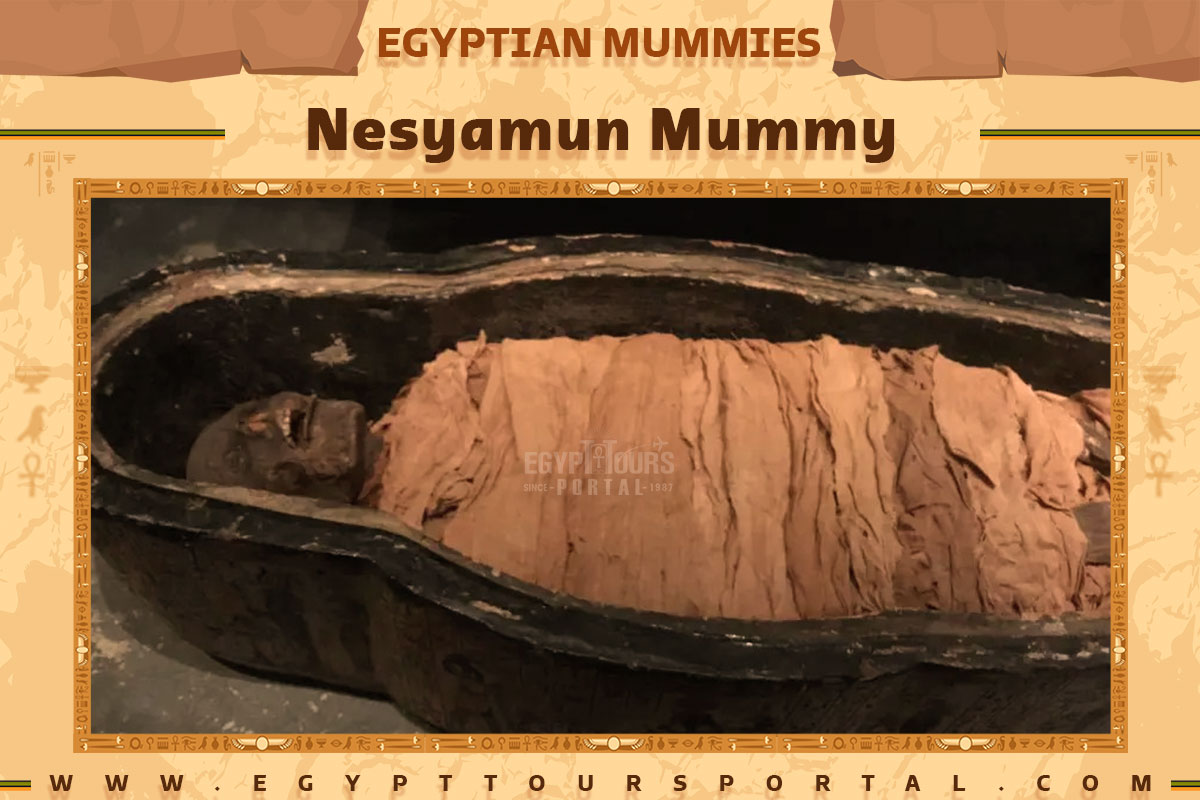
Nesyamun's mummy was examined in 1824 and was wrapped in multiple layers of linen, surrounded by floral garlands, and adorned with a red leather ornament. It was covered with a layer of spicery and well-preserved. Bandages showed signs of recycling clothing, and his body cavity was filled with the same substance as the skin. His brain was removed through the right nostril, and organs through a left-side incision. Nesyamun's X-rays in 1931–32, 1964, and 1989 revealed various details. The back of his skull was removed in 1824.
His teeth were worn, with some front teeth becoming peg-like, possibly from acidic fruit or over-cleaning. Gum disease but no cavities were found. His eyes showed nerve degradation, potentially linked to diabetes. He had O-type blood, a narrowed intervertebral disc with osteophytes, and signs of osteoarthritis. Filarioidea worms in his groin indicated filariasis, and atherosclerosis was seen in his arteries. Nesyamun was 5 feet 6 inches tall and died aged 40–50, and his cause of death is uncertain. His protruding tongue suggests an unusual circumstance; it's speculated he died violently by strangulation, but his hyoid bone was intact. Another theory is swelling due to disease or allergy.
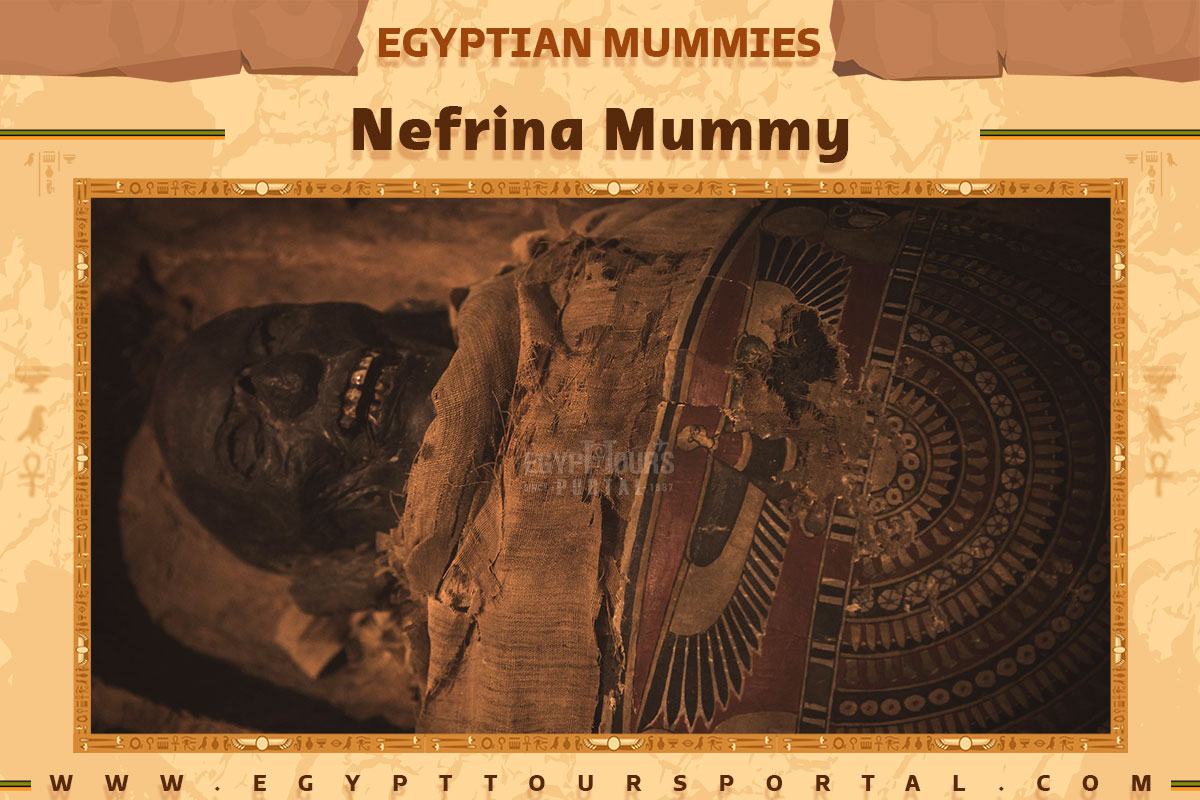
Nefrina which means "A Good Thing Has Come to Us" lived in Akhmim, Egypt, around 250 BC. She was mummified in the upper-class style and died around 275 BC, possibly due to complications from a broken hip. Her father was a clergy member, and her mother played the sistrum for Min. Her mummy was discovered in the late 19th century, acquired by the University of Pennsylvania, and then moved to the Reading Public Museum in 1930, where it's still on display.
Nefrina's mummy has been at the Reading Public Museum since 1930, where it's a prominent artifact. Unlike other mummies, Nefrina's organs were cleaned, dried, and returned to her body, and a medical poultice was applied to her injured hip after death. Her face has been reconstructed using CAT scans and depicted in a beautiful sculpture found in the museum.
The discovery of new mummies is happening all over Egypt which continues to unveil new facts about great individuals and incredible time periods. The advent of X-ray technology enables the non-destructive examination of mummies, aiding in uncovering information beneath the intricate wrappings. This approach, coupled with autopsies on unwrapped bodies, allows experts from all over the world to unveil Egyptian health issues and medical practices.
Analyzing bones offers insights into average height, life expectancy, and even the chronological sequence of Egyptian rulers based on age at death. Additionally, examining the skulls of successive pharaohs hints at familial connections and a number of incredible facts. Despite the passage of millennia, mummies persist as a valuable source of information, providing us with a window into the past.
The ancient Egyptian mummies till our current day still grab the attention of modern scientists, historians, and skilled archaeologists who attempt to give a full understanding of the concept of mummification and the corresponding culture that surrounds them. The mummies will get to unveil deep intricate details accompanied by some of the finest treasures which will showcase how the ancient Egyptians tried to earn their way to the heavens.
Ancient Egyptian Mummies are the embodiment of ancient Egyptian beliefs that showcased some of the incredible facts about the greatest civilization to ever exist and achieve immortality. Discover the Wonders of Ancient Egypt with our Egypt classic tour packages! Explore the mysteries of the pyramids and uncover the secrets of the mummies.
Private 4 Days Cairo Tour Packages for Australian Travelers 4 days Cairo Egypt Tour ...
Tour Location: Cairo – Giza...
5 Days Cairo and Alexandria Tour Package For Australian Travelers 5 days Cairo and A...
Tour Location: Cairo/Giza/Alexandria...
6 Days Cairo, Luxor & Aswan Tour Package For Australian Travelers 6 days Cairo, ...
Tour Location: Cairo/Giza/Aswan/Luxor...
Amazing 7 Days Cairo and Hurghada Holiday for Australian Travelers 7 Days Cairo &...
Tour Location: Cairo – Giza – Hurgh...
The most famous mummy in the entire history of the ancient Egyptian civilization belongs to Pharaoh Tutankhamun whose tomb was discovered fully preserved and completed by archaeologist Howard Carter in 1922. The media has put his mummy and tomb in the spotlight for many years due to the five thousand artifacts and treasures discovered in great condition. Also, the pharaoh's curse was highly popularized across all media channels thus making it even more famous and full of mystery to our current day.
The mummification process was the ultimate way to preserve the body so it reunites with the soul so it can enter the gates of the fields of reeds.
The mummies were entirely drained of any liquids by removing internal organs, drying the body, and wrapping it in linen bandages.
These four organs were put in canopic Jars which included the lungs, intestines, stomach, and liver. The canopic jars are known to represent the four sons of Horus: Imsety, Hapi, Duamutef, and Qebehsenuef.
The social states and socioeconomic hierocracy played a vital role in the shape of the mummies. The quality of the mummies and the materials used determine the price that was paid. It is worthy to know that the mummification process was performed on all kinds of people from commoners to priests.
The ancient Egyptians mummified different animals for religious reasons like making an offering to the ancient Egyptian gods and goddesses like cats, dogs, and birds.
The Egyptian mummies are still called "Mummies" which is used universally to describe preserved human or animal remains from ancient Egypt or other cultures.
Mummies have captured the imagination of people worldwide and contributed to the fascination with ancient Egypt. Mummies were famous in Ancient Egypt for being an integral part of ancient Egyptian culture and religious beliefs which symbolize the magical journey to the afterlife. The preservation techniques used in mummification revealed a great deal of facts about ancient Egyptian anatomy, culture, and history.
The oldest mummy ever discovered in Egypt was found in a tomb near the famous Saqqara pyramid. The mummy is believed to be nearly 4,300 years old and belonged to a man named Hekashepes who was a supervisor of nobles, an inspector of officials, and a priest during the reign of the last pharaoh of the fifth dynasty Unas, and was discovered 15 meters below the ground in a sealed limestone sarcophagus that featured gold-leaf covering. It is considered by far to be the oldest and most complete mummy found in Egypt to date.
The most famous mummy ever found is the tomb of Tutankhamun which was discovered by Howard carter on 28 October 1925 in tomb KV62 in the Valley of the Kings.
The entire country of Egypt deserve to be explored with its every heavenly detail but there are places that must be seen before any other such as the breathtaking Hurghada's red sea, The wonders of Cairo the pyramids of Giza, the great sphinx, the Egyptian Museum, Khan El Khalili Bazaar, the wonders of Luxor like Valley of the Kings, Karnak & Hatshepsut temple and the wonders of Aswan such as Abu Simbel temples, Philea temple, Unfinished obelisk and The Wonders of Alexandria like Qaitbat Citadel, Pompey's Pillar and Alexandria Library. Read more about the best places to visit in Egypt.
If you want to apply for a Visa On Arrival that lasts for 30 days then you should be one of the eligible countries, have a valid passport with at least 6 months remaining and pay 25$ USD in cash, as for the E-Visa for 30 day you should have a valid passport for at least 8 months, complete the online application, pay the e-visa fee then print the e-visa to later be presented to the airport border guard. You could also be one of the lucky ones who can obtain a free visa for 90 days. Read more about Egypt travel visa.
Egypt has a variety of delicious cuisines but we recommend “Ful & Ta’meya (Fava Beans and Falafel)”, Mulukhiya, “Koshary”, a traditional Egyptian pasta dish, and Kebab & Kofta, the Egyptian traditional meat dish.
The best time to travel to Egypt is during the winter from September to April as the climate becomes a little tropical accompanied by a magical atmosphere of warm weather with a winter breeze. You will be notified in the week of your trip if the Climate is unsafe and if any changes have been made.
You should pack everything you could ever need in a small bag so you could move easily between your destinations.
We have been creating the finest vacations for more than 20 years around the most majestic destinations in Egypt. Our staff consists of the best operators, guides and drivers who dedicate all of their time & effort to make you have the perfect vacation. All of our tours are customized by Travel, Financial & Time consultants to fit your every possible need during your vacation. It doesn't go without saying that your safety and comfort are our main priority and all of our resources will be directed to provide the finest atmosphere until you return home.
You will feel safe in Egypt as the current atmosphere of the country is quite peaceful after the government took powerful measures like restructuring the entire tourist police to include all the important and tourist attractions in Egypt. Read more about is it safe to travel to Egypt.
Wear whatever feels right and comfortable. It is advised to wear something light and comfortable footwear like a closed-toe shoe to sustain the terrain of Egypt. Put on sun block during your time in Egypt in the summer to protect yourself from the sun.
The best activity is by far boarding a Nile Cruise between Luxor and Aswan or Vise Versa. Witness the beauty of Egypt from a hot balloon or a plane and try all the delicious Egyptian cuisines and drinks plus shopping in old Cairo. Explore the allure and wonders of the red sea in the magical city resorts of Egypt like Hurghada and many more by diving and snorkeling in the marine life or Hurghada. Behold the mesmerizing western desert by a safari trip under the heavenly Egyptian skies.
There are a lot of public holidays in Egypt too many to count either religious or nation, the most important festivals are the holy month of Ramadan which ends with Eid Al Fitr, Christmas and new years eve. Read more about festivals & publich holidays in Egypt.
Egypt is considered to be one of the most liberal Islamic countries but it has become a little bit conservative in the last couple of decades so it is advised to avoid showing your chest, shoulders or legs below the knees.
Arabic is the official language and Most Egyptians, who live in the cities, speak or understand English or at least some English words or phrases. Fewer Egyptians can speak French, Italian, Spanish, and German. Professional tour guides, who work in the tourism sector, are equipped to handle visitors who cannot speak Arabic and they will speak enough English and other languages to fulfill the needs of all our clients.
The fastest way is a car, of course, a taxi. If you are in Cairo ride a white taxi to move faster or you could board the fastest way of transportation in Egypt metro if the roads are in rush hour.
The temperature in Egypt ranges from 37c to 14 c. Summer in Egypt is somehow hot but sometimes it becomes cold at night and winter is cool and mild. The average of low temperatures vary from 9.5 °C in the wintertime to 23 °C in the summertime and the average high temperatures vary from 17 °C in the wintertime to 32 °C in the summertime. The temperature is moderate all along the coasts.
It is the home of everything a traveler might be looking for from amazing historical sites dating to more than 4000 years to enchanting city resorts & beaches. You will live the vacation you deserve as Egypt has everything you could possibly imagine.









